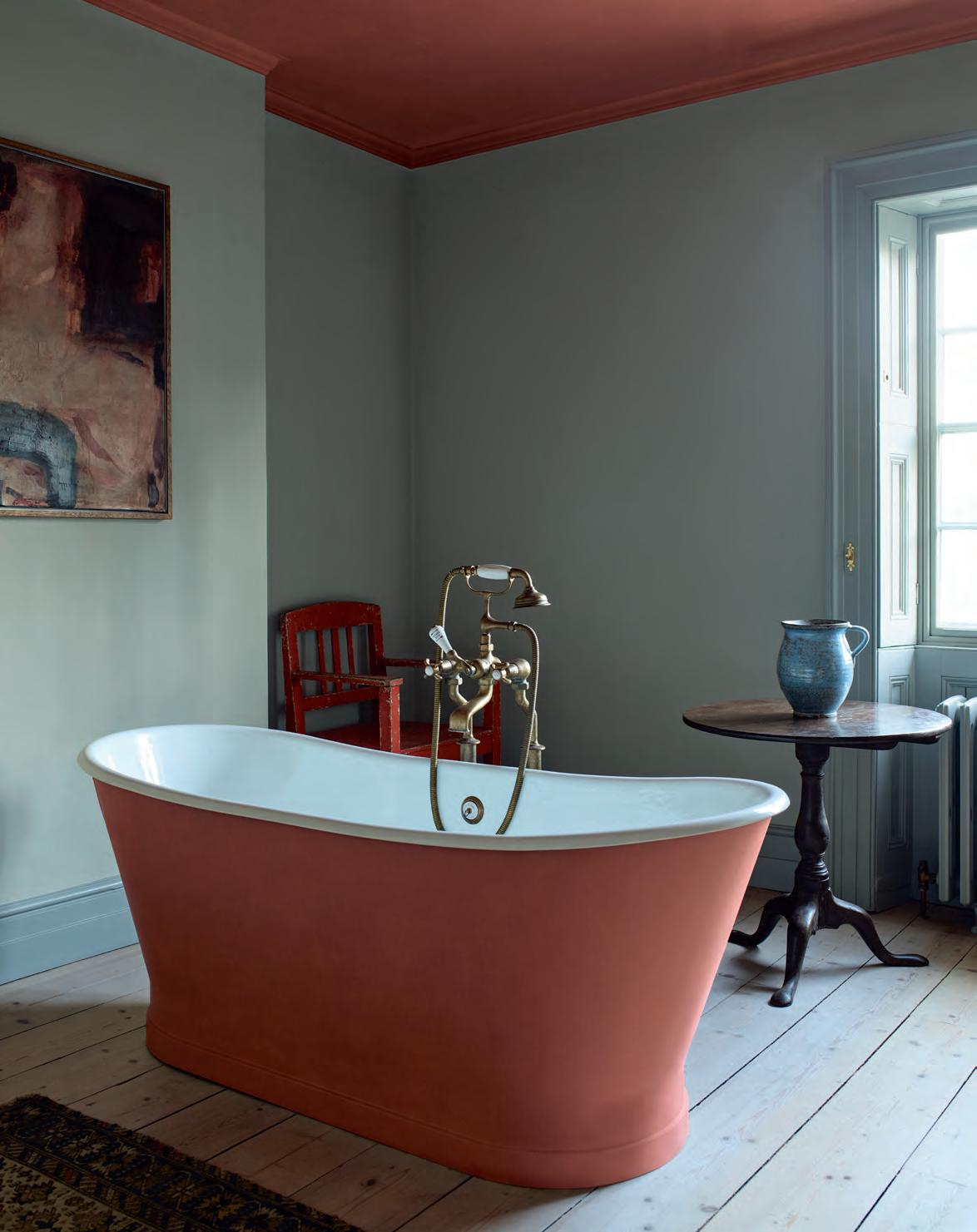STORIES




Pablo Picasso once pondered: “Why do two colours, put one next to the other, sing? Can one really explain this?” And in some ways, what makes a colour pairing harmonise is hard to articulate. But in other ways, we need only look to nature to see a myriad of hues working together – or contrasting with each other – to discover the key to the world’s most beautiful colour schemes.
Appreciation of nature has always been a guiding principle for us at Neptune. In the materials we use, the finishes we prefer, and in our colour palettes. Even our paint collection is curated into elements from the natural world: Plant, Timber, Fossil and so on.
But along with a respect for what nature does, well, naturally, so we also look to how artists interpret the world around them. Neptune’s creative founder Emma Sims-Hilditch always recommends analysing a favourite painter’s choice of colour combinations as a useful starting point to establishing a room’s colour scheme. Because colour is ultimately a personal response.
And so, in this issue of Stories we explore colour in all its variances – from the subtleties of shaded white walls which can have profound effects on a space, to the vibrancy – and horticultural history – of our new seasonal colour, Rhubarb.
But, as ever, colour is just one part of our personal picture. How we curate a space, what we choose to keep, to show, to tuck away is of equal importance to how we feel about a home. For historian Lucy Worsley, it is cooking over a pot at her kitchen island that most roots her to her surroundings – and the generations before her who have stood preparing food for loved ones. For adventurer Ben Fogle an indoor-outdoor connection with nature, through his choice of colours and pattern and textures, has made his house feel like home.
For just as our response to colour is individual, so too is our idea of home. Which makes designing interiors forever fascinating. And curating a room of one’s own forever rewarding.
Thank you to the talented authors and journalists who contributed to this edition, along with our fabulous team of in-house writers.
Suzanne Imre


For seventeen years, Suzanne Imre was the influential editor of interiors magazine Livingetc; a renowned style pundit and trend leader. Today, she lives in London and works as a brand consultant, content director and writer.

@suzanne.imre
Lucy Worsley


Lucy Worsley OBE is Chief Curator at Historic Royal Palaces. She presents TV programmes including: Six Wives with Lucy Worsley and Victoria & Albert: The Royal Wedding. Lucy Worsley is the author of several acclaimed books including Jane Austen at Home (Hodder, 2017), and her new biography, Agatha Christie (2022), published by Hodder & Stoughton. @lucy_worsley Photograph by Sophia Spring
Ben Fogle
Ben Fogle is a broadcaster, adventurer and author. He has climbed Mount Everest, rowed the Atlantic and raced to the South Pole. Ben presents programmes including C5’s New Lives in the Wild. He is the United Nations’ Patron of the Wilderness. @benfogle

Sarah Jane Bellmaine
Sarah Jane Bellmaine is Neptune’s lead chef at The Provenist, based at the Wiltshire HQ. She previously worked as head pastry chef for one of the UK’s top public schools, alongside running a successful luxury bakery company. She lives near Swindon with her husband and two children. @chef_sarahjanee
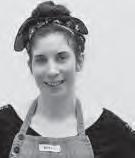
Isabella Tree
Author and conservationist Isabella Tree’s bestselling book ‘Wilding – the return of nature to a farm’ tells the story of how she and her husband, the conservationist Charlie Burrell, rewilded their farm at Knepp Castle in Sussex. Her latest book, ‘The Book of Wilding – a practical guide to rewilding, big and small’ is published by Bloomsbury in May 2023. @isabella.tree Photograph by AnthonyCullen
Fleur Britten
Fleur Britten is a freelance journalist who writes for national newspapers and glossies. Formerly of Sunday Times Style for 15 years, she is also the author of five published books. She lives in Sussex with her two children and two cats. @fleurbritten


Sam Scott Jeffries

Samantha Scott-Jeffries is the editor of The English Home magazine. She has been an interiors journalist for over twenty years in which time she has worked in television, print and has written several books. She lives in the Cotswolds. @samanthascott-jeffries
@theenglishhome Photograph by Grant Scott
Giles Kime
Hampshire-based Giles Kime is executive editor of Country Life magazine and author of a number of books on interior design including The Evolution of Home with Neptune’s creative founder, Emma Sims Hilditch, published by Rizzoli. A new book with Nina Campbell is published this Spring, also by Rizzoli, titled A House in Maine. @giles.kime

Jo Rodgers

American born Jo Rodgers is a journalist who lives in London and East Sussex with her husband and two children. She is a contributing writer at Vogue, Conde Nast Traveller, House & Garden, and Country Life. @jo_rodgers
Jessica Doyle
Jessica Doyle is design and interiors editor at the Telegraph, and has previously written for publications including the FT, House & Garden, Country & Town House and Homes & Gardens. She lives in south-east London with her husband and their two children. @tjedoyle
Arthur Parkinson
Arthur Parkinson is a writer, podcaster and gardener from Nottinghamshire. He is known for his love of farm animals, especially chickens, through his Instagram posts and illustrations. He keeps many hens, with his latest book titled Chicken Boy by Penguin, being a tribute to his favourite chicken breeds. @arthurparkinson_
Paula Sutton
Paula Sutton founded interiors and lifestyle brand Hill House Vintage in 2010 when she moved from London to the Norfolk countryside with her family. For years she worked in fashion publishing, at Elle magazine and Elite Premier Models. @hillhousevintage
4
Perfectly imperfect beauty
Suzanne Imre
8
The heart of the home
Lucy Worsley OBE
10
Why we curate
16
Two worlds
Ben Fogle
18
On Rhubarb
22
This is Odette
24
An evolving home
Sam Scott Jeffries
28
Introducing Aalish
30
Colour Knowledge
36
This is Ardingly
38
The cutting edge
Giles Kime
42
A blank canvas
Jo Rodgers
44
In the kitchen: recipes
Sarah Jane Bellmaine
50
Book club: an arboreal read
Isabella Tree
52
Colour scheming
Emma Sims-Hilditch
58
How to: tie a reef knot
60
This is Rhubarb
62
Glass houses
Fleur Britten
66
Ben and Marina Fogle & their Suffolk kitchen
70
Fine tuning
Jessica Doyle
74
This is the Chichester workstation
76
How to: keep chickens
Arthur Parkinson
78
Making it local
82
All a’flutter
Paula Sutton
Neptune co-founder John Sims-Hilditch explains to editor
Suzanne Imre why beautiful design is more than skin deep.
The American architect Frank Lloyd Wright once said, “If you foolishly ignore beauty, then you will soon find yourself without it.” For Lloyd Wright, beauty was achieved by seamlessly linking architecture to its surroundings, as exemplified by his famed Fallingwater House in Pennsylvania, described by Time Magazine as the architect’s “most beautiful job”. While the aesthetics of its modernist, jutting terraces may not appeal to all, its breathtaking position over a waterfall, and material emersion in the rocky woodland, ensures it is a design feat of uncommon beauty.
And it is this idea of understanding what makes something truly beautiful that Neptune’s co-founder John Sims-Hilditch is keen to explore – and apply to Neptune’s collections. “It’s worth tackling the word ‘beauty’,” says John, “as there is a perhaps misguided view that beauty is a superficial thing. In truth, it has a much deeper meaning and if we open up to it, we realise that attractive surface forms are not necessarily real beauty.” Instead, John suggests we tap into our primeval response to beauty and rediscover an appreciation of the unexpected, the hidden, even the not traditionally good looking.
“While here at Neptune we seek a visual beauty in our designs, we also seek a complete beauty,” explains John, “and that starts with making furniture with the best and most appropriate materials, using the best joints and internal mechanics that may not be visible but because they are made with care, they make a difference.”
Nature also plays a big part in deepening our understanding of what is beautiful because connecting with the natural world helps us realise that perfection is not necessarily the end goal. “Nothing is perfect in nature,” says John, “yet the imperfections are perfect. A tree struck by lightning which continues to grow at odd angles might be the most beautiful tree in the forest. It has dealt with adversity and the scars are its story.”
It is this sense of a life, a history, that pervades Neptune’s approach to the oak that makes up so much of its furniture. “We made an early decision to retain as much of the natural grains of the woods as we could,” says John. “Yes, we need to protect the surface, but we need to connect with the pure beauty of the wood as well. It’s why we devised our subtle IsoGuard® finish. A wooden table contains the story of its journey as a living thing; you’re looking at eighty years of life in the grain of our oak tables. That, in itself, is beautiful.”
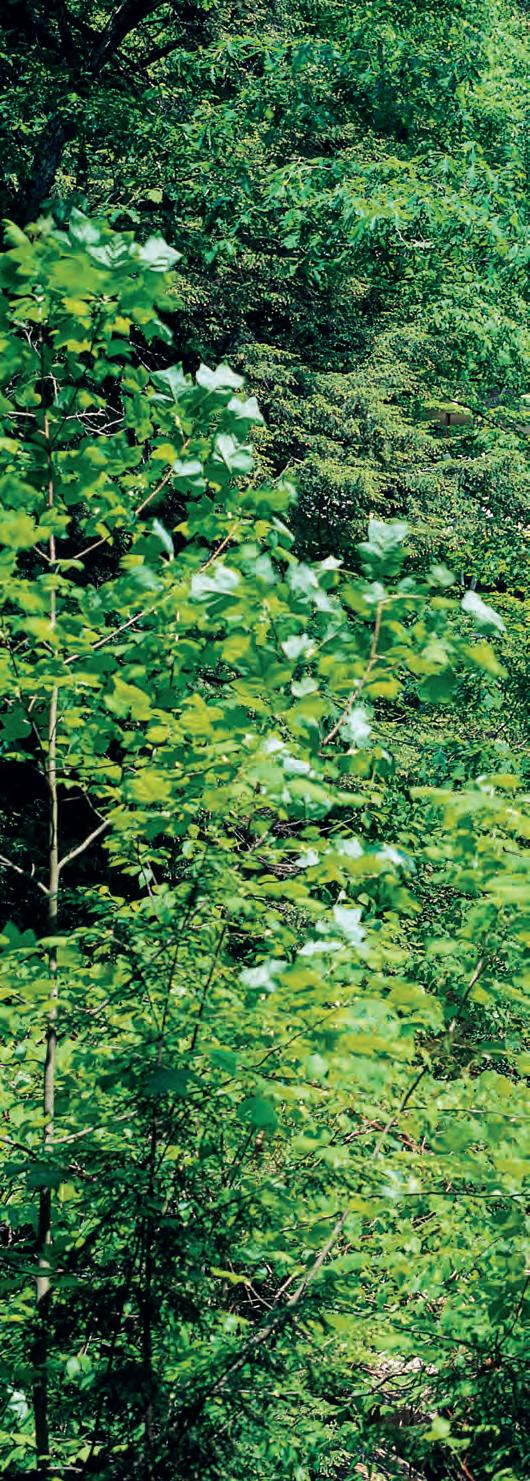
So, the idea of beauty as something that is merely lovely to observe is missing the point. As Lloyd Wright’s Fallingwater House exemplifies, and as John explains it, real beauty is about looking beyond the surface and connecting with nature. Yes, it might be about an attractive exterior but it’s also about appreciating good bones, hidden details and perfect flaws.


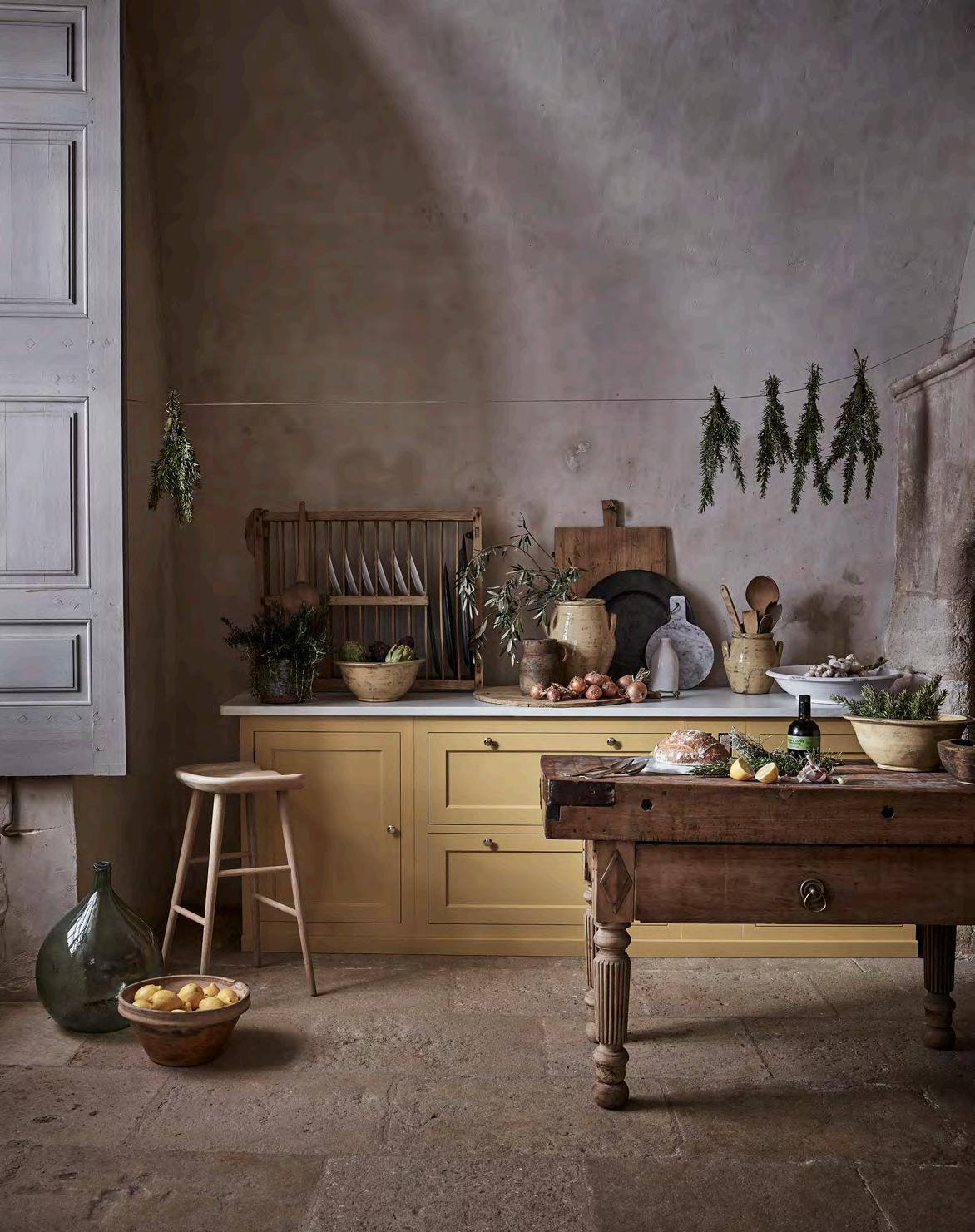
If I have a day off, I’m often to be found stirring vegetable soup. To me, it’s relaxing to stand by my hob in its island unit, at the centre of my open-plan flat in London. As I stir, I sometimes like to think of the giant changes in women’s lives that have taken place since the soup-makers who’ve gone before me.
For example, I imagine the inhabitants of a medieval peasant’s cottage like the one you can visit at the Weald and Downland Museum, a collection of historic buildings in Sussex. With its thatched roof and windowless stone walls, it was a place that sparked my love of history as a kid.
My airy modern flat is light years away from it, but perhaps the one thing that connects me to that cottage life is the idea that cooking lies at the heart of a home.
The open hearth was so important the medieval authorities didn’t enumerate buildings or souls but hearths, and made people pay a hearth tax. Over a flat firestone in the centre of the cottage, women cooked pottage, a sludgy soup named for the round-bottomed iron pots that were easy to nestle into a sandy floor if you didn’t have a table.
When British people began to live in towns, though, and aspired to bigger houses with servants, cooking was pushed into the background. It became posh to eat in a different room, a dining parlour, or even an elegant banqueting house, and to keep food preparation out of sight and out of mind. The grandest Georgian country houses had kitchens in separate blocks.

In Victorian cities, with space at a premium, kitchens were squeezed underground, into dark and dingy basements. They were unpleasant places to be. It amazes me that the Victorians were so slow to adopt laboursaving devices. When the dishwasher was invented (by a woman – naturally) it didn’t catch on, because domestic labour was so plentiful and cheap.
The one big innovation was the switchover from the open fire to the enclosed cooking range for greater fuel efficiency. And people replaced their cauldrons with flatbottomed saucepans for cooking on a hob like mine.
After the First World War, though, domestic service was beginning to come to an end. And you get the sense, for the first time in centuries, that homeowners had to re-enter their kitchens. They made the best of it, reinventing fancy cooking as a middle-class pastime. Even the intellectual Virginia Woolf went for cookery lessons, although she managed to bake her wedding ring into a suet pudding.
Since then, we’ve had this idea that cooking can be a high-status activity, and that a kitchen is worth making beautiful. Unlike the hardworking woman who lived in that windowless cottage, I make soup not because I have to, but because I want too. But it’s true for both of us that the kitchen’s where domestic life truly unfolds.
Historian, author and tv presenter Lucy Worsley contemplates what the kitchen has meant to generations of cooks over the centuries.
(noun) Origins: Curate comes from the Latin curare, meaning ‘take care of’
An edited selection. It’s something that typifies Neptune’s ethos. It’s how every collection is approached; so there’s something for (just about) every home, but not so much that things become overwhelming. And as Neptune curates its designs, patterns, and paint colours, we curate our homes. So that well-made pieces are cared for and have longevity, and possessions steeped in personal history go on telling their tales.

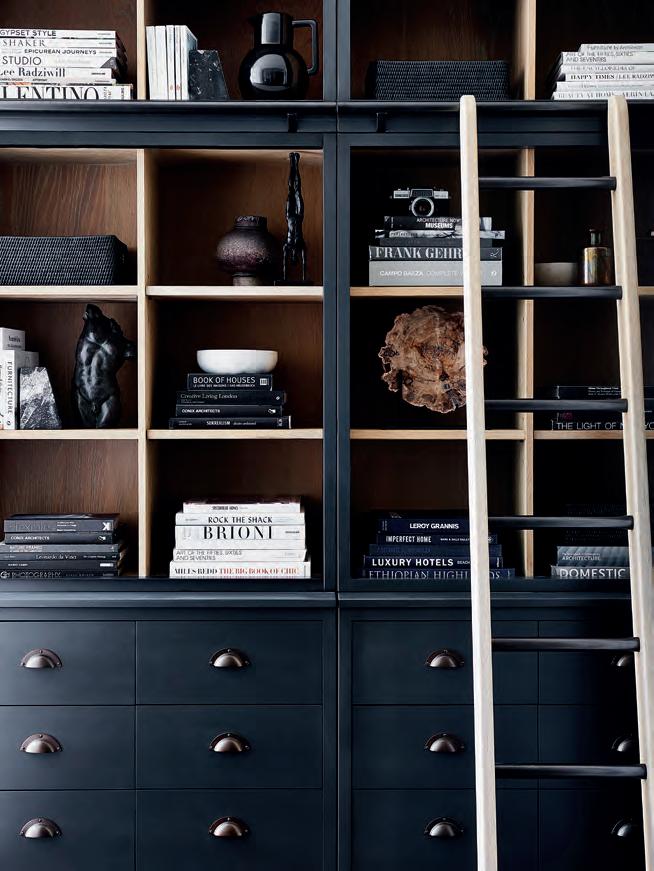
We curate every day. Often without realising it. We curate the things we wear. The things we eat. Even what we say. But curating our home – taking time to select, organise and care for the pieces we live with – has a wider resonance. For our visitors, friends, and family benefit from our editing endeavours just as we do. And our surroundings benefit too.
A curated home feels both intriguing and restful. A place of tantalising personal stories, and at the same time, a calm and ordered space where favourite pieces have room to breathe. It's something we learn to do over time. Our editor’s eye grows in confidence as we discover preferred colour combinations, an understanding of shape and scale, and an appreciation of materials and finishes.
Curated collections may well consist of larger pieces of furniture, art, or the like. But for those that are smaller in scale, there’s the matter of ‘where’ to consider too. It might be that yours is simply displayed on a ledge or bookcase, arranged artfully alongside well-thumbed paperbacks and hardbacks. For more expansive collections, a cabinet or dresser will create space for personality, allowing its contents to evolve alongside you and your home, while keeping it ordered and contained.
Take our new Portobello cabinet, as well as its older cousins, Shepton and the newly-updated Ardingly. All three make excellent candidates; their beauty lying in both their capacity and versatility. Portobello and Shepton have glassfronted doors, so that your curios stay safe (and dust-free) and are visible for all to see. Ardingly’s doors are made from solid timber, but the design lends itself to leaving one or both doors open invitingly to reveal the contents within.
Of course, there’s the inimitable dresser too, the home curator’s companion stretching as far back as the 17th century. Styles like Chichester, Suffolk, Henley, and modular Chawton offer different combinations of doors, drawers, cupboards and open shelving for collections of all shapes and sizes.
Finally, don’t forget that part of the reward of curating lies in the process itself. Pausing to take stock of what we have, to rethink how we might use or display it. To appreciate it. And, while everyone’s curation journey is different, our guiding principles are the same: to select, organise and care for the things we love to live with.
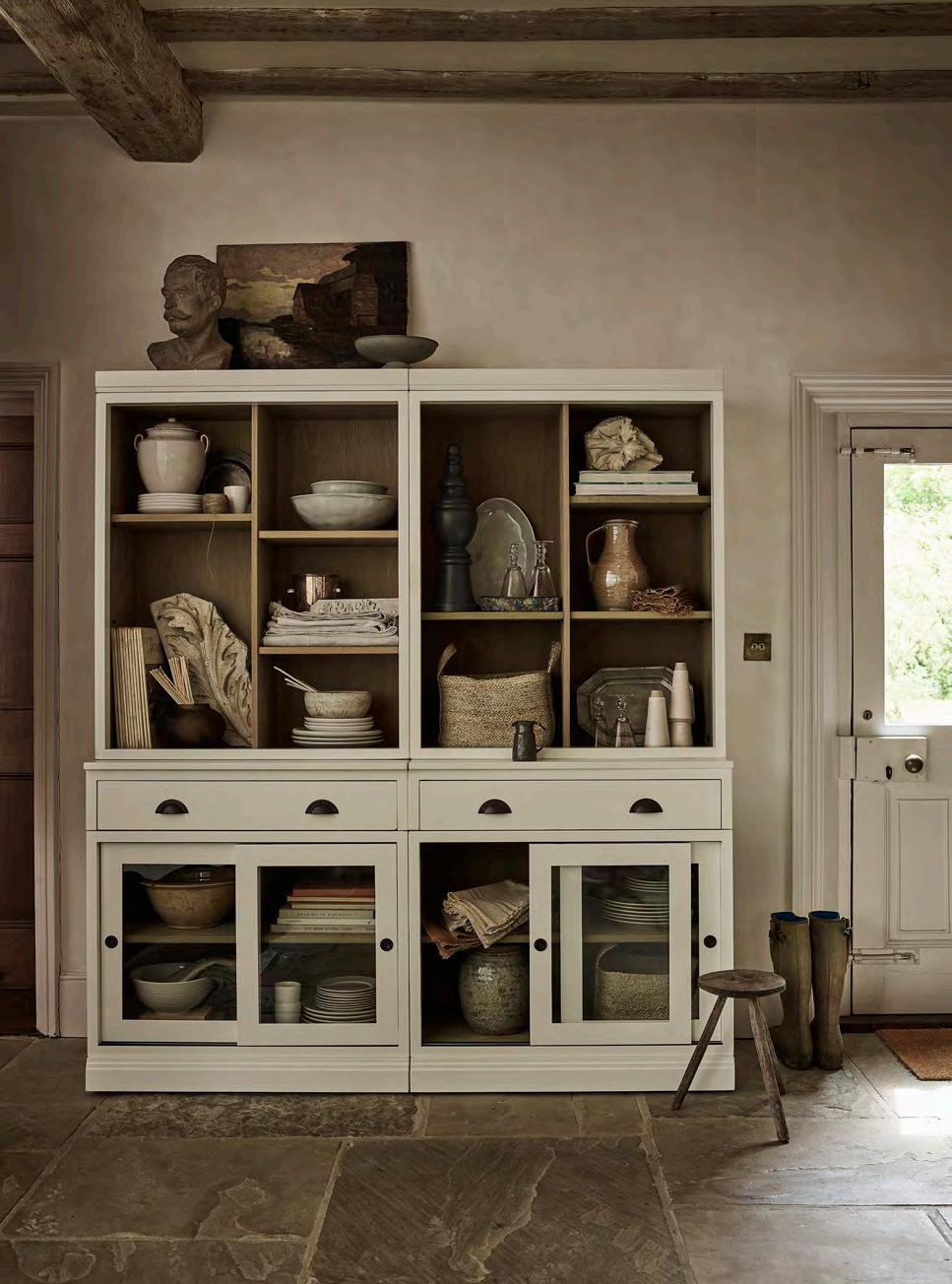
1. Curate to select the best Paying attention to quality, finishes, details. Buy less, buy well.
3. Curate to care for something
Understanding how to look after furniture and natural materials like oak, linen and velvet.
5. Curate to simplify
Focusing on understated elegance and considered design. It doesn’t have to mean minimalist; it just means there’s a sense of serenity.
7. Curate to display
Showcasing edited, treasured pieces on walls and dressers, and in cabinets. This is about sharing our stories with others.
1 3 5 7
2. Curate to organise
A focus on getting cupboards, drawers and rooms in order.
4. Curate to tell a story
Selecting pieces that sit together with a cohesive backstory – a colour, texture, style, or period of history that links them.
6. Curate to highlight heroes
Working out what the heroes of the room are. And what pieces support those heroes.
8. Curate for the future
Identifying and preserving heirlooms to pass onto the next generation and investing in future classic designs.
2 4 6 8
Nature is our most powerful tool. It can heal us. It can teach us, and it can warn us. It is a marker for the health of our planet and therefore the health of humanity. And it’s for this reason that it has always perplexed me that we draw a line between inside and outside.
We need a barrier for protection against the elements, of course, but there's no need to keep nature outside. We have always tried to blur the lines between the two. Our family home is a riot of nature. Decorated with soft greens and browns, it mirrors the garden beyond. The windows are the portals that merge the two worlds.
The house is filled with natural wood, soft, faded linens and other fabrics that merge seamlessly into the world beyond. I have long been a collector of antiques, with a particular love of folk art. There is something very alluring about the simplicity of furniture and art made with the simplest materials, often to a very simple design.
The house, just like nature, makes me smile and helps me relax.
Our home is surrounded by gardens, woods and ponds which are rich in flora and fauna. We have deer grazing by our pond and wild wallabies leaping through the garden. The interiors bring some of this to life, particularly in the winter months when the colours outside are more toned down. Filled with dogs and house plants, it can feel like we are enveloped in a little bit of the outdoors, indoors.
We know nature is nurturing and healing, with positive effects on our mental health. Connecting with the outdoors is even prescribed by doctors for improving our wellbeing. There has long been a tradition of forest bathing in Japan and Scandinavia, where the relationship between nature and health has been acknowledged for generations. So, is it any surprise that both Japanese and Scandinavian interiors incorporate a simple air of nature into their most successful living spaces. And that the most relaxing and soothing homes in the world are often those which link directly to the worlds outside their windows.
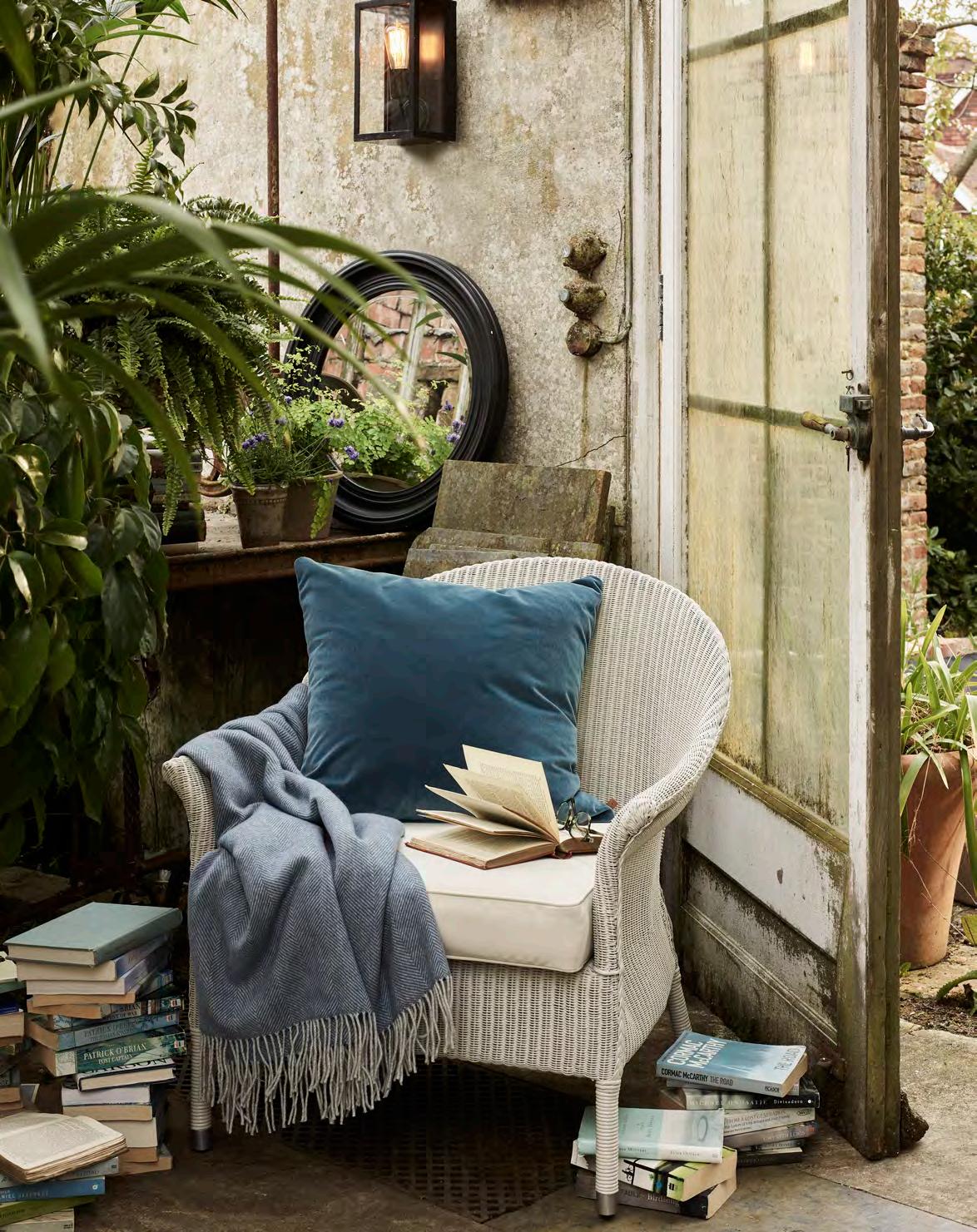
Discover the long horticultural history that lies behind our new colour’s namesake.
It was during a review meeting for Spring 23 that co-founder John Sims-Hilditch named our new coral colour ‘Rhubarb’. Observing the richly pigmented, heritage shade, John noted its connection with the vivid rhubarb stalks of many an English garden, as well as the earthier hue of the weathered terracotta forcers that the plant grows in. And so, our seasonal colour was christened. But dig deeper, and this humble vegetable has a history as rich as its colourful stalks.

It was the Venetian explorer Marco Polo who first brought rhubarb (along with gunpowder and paper money amongst other sundries), to Europe from China, where the plant had been prized for its medicinal purposes. As a soughtafter Silk Road import, the stalks soon commanded three times the price of saffron and opium.
But it was the carelessness of a gardener, on a winter’s day in the Chelsea Physic Garden in 1817, that gave rise to the sweeter pinky-red vegetable we enjoy today – forced rhubarb.


The young gardener covered some rhubarb roots with soil and forgot about them for a few frosty weeks. Dusting away the soil sometime later, he noticed tender pink shoots emerging from the dark earth, which grew into stalks with a far superior flavour and quality than anything that had been grown in British soil before.
Before long, forced rhubarb fields were springing up in London until it was discovered that the dank climate of the Pennines offered the perfect growing conditions. Winter frosts would trigger a chemical reaction in the rhubarb roots and ‘force’ the plant to produce a crop. What became known as the ‘rhubarb triangle’ – a stretch from Leeds to Wakefield to Bradford – was soon recognised as the forced rhubarb centre of the world.
Sadly, what was once a thriving industry of over 200 producers – nurturing rhubarb shoots in darkened sheds and harvesting by candlelight – has today been reduced to a handful of ardent growers and gardeners who rely on the domed terracotta pots to keep the roots in darkness. But local artisans, chefs and restauranteurs are leading a rhubarb revival, offering it in varied forms from soups to beers to ice cream.
And now, we are celebrating this intrepid plant in interiors. Our Rhubarb shade sits comfortably between the earthiness of those clay forcer pots and the prettiness of coral. Smart and contemporary when paired with whites, or a perfect foil to the freshness of greens like Quince, Rhubarb carries with it the dignity of its rich heritage and the freshness and optimism of nature.
Experiment with Rhubarb in your own home using our eggshell and matt emulsion sample pots – simply order online or pick one up in store.
To see how we’ve been using the shade, head to our Instagram @neptunehomeofficial
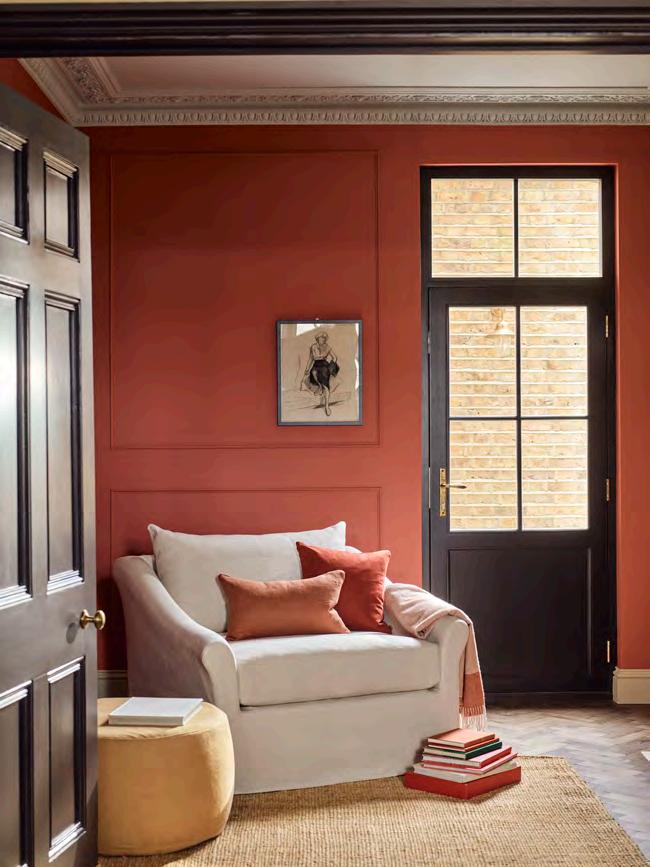
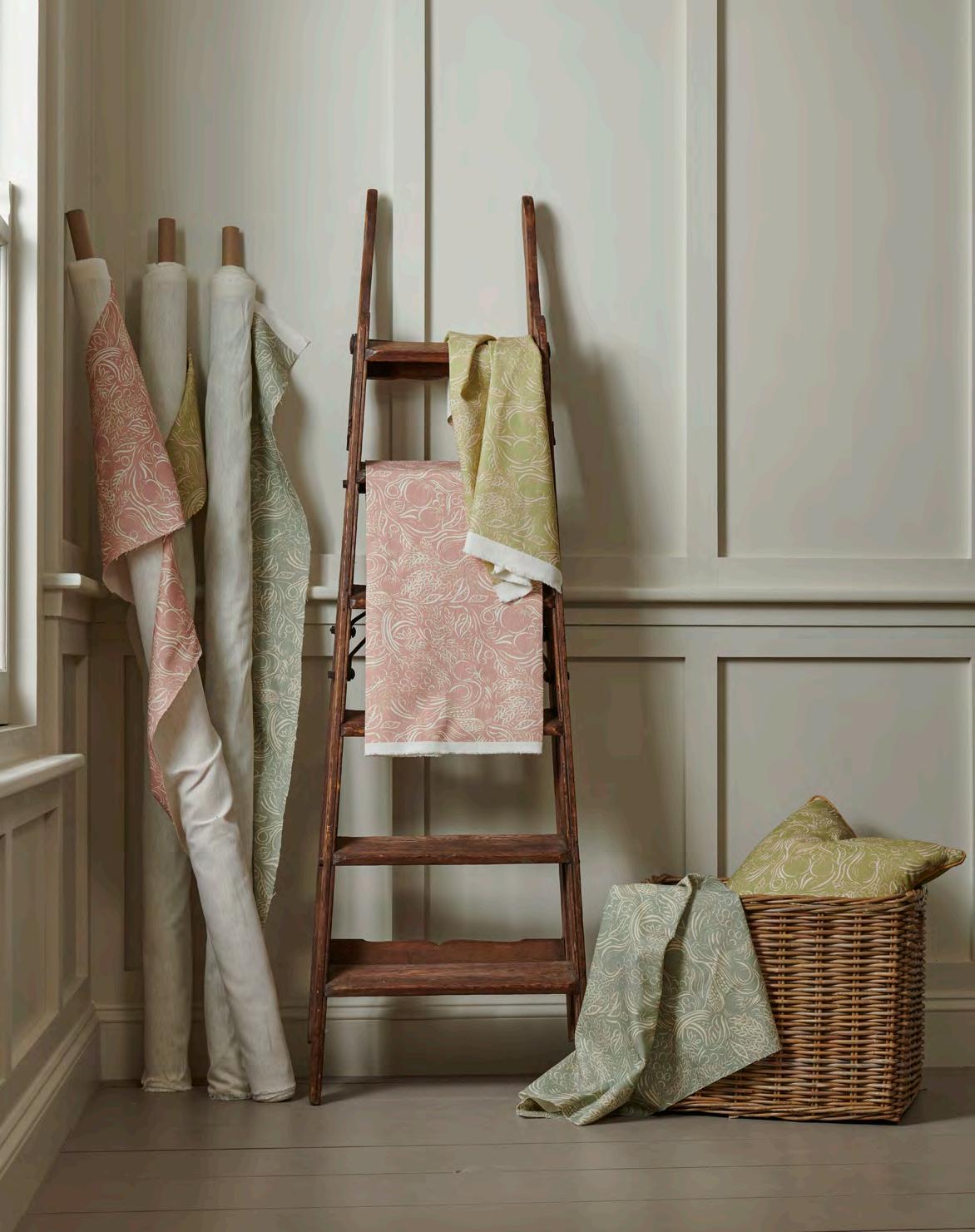
This is
A walk past a country church decorated for the harvest festival was the starting point for our Odette fabric by textile designer Beki Bright. “It sparked an idea, so I found some 18th century etchings of harvest celebrations, set up my own still life display, and began drawing,” says Beki. This season, Odette is available in three new nature-inspired hues: Old Rose, Quince and Alpine. Printed in Lancashire, the linen and cotton mix is suitable for upholstery, curtains and cushions.
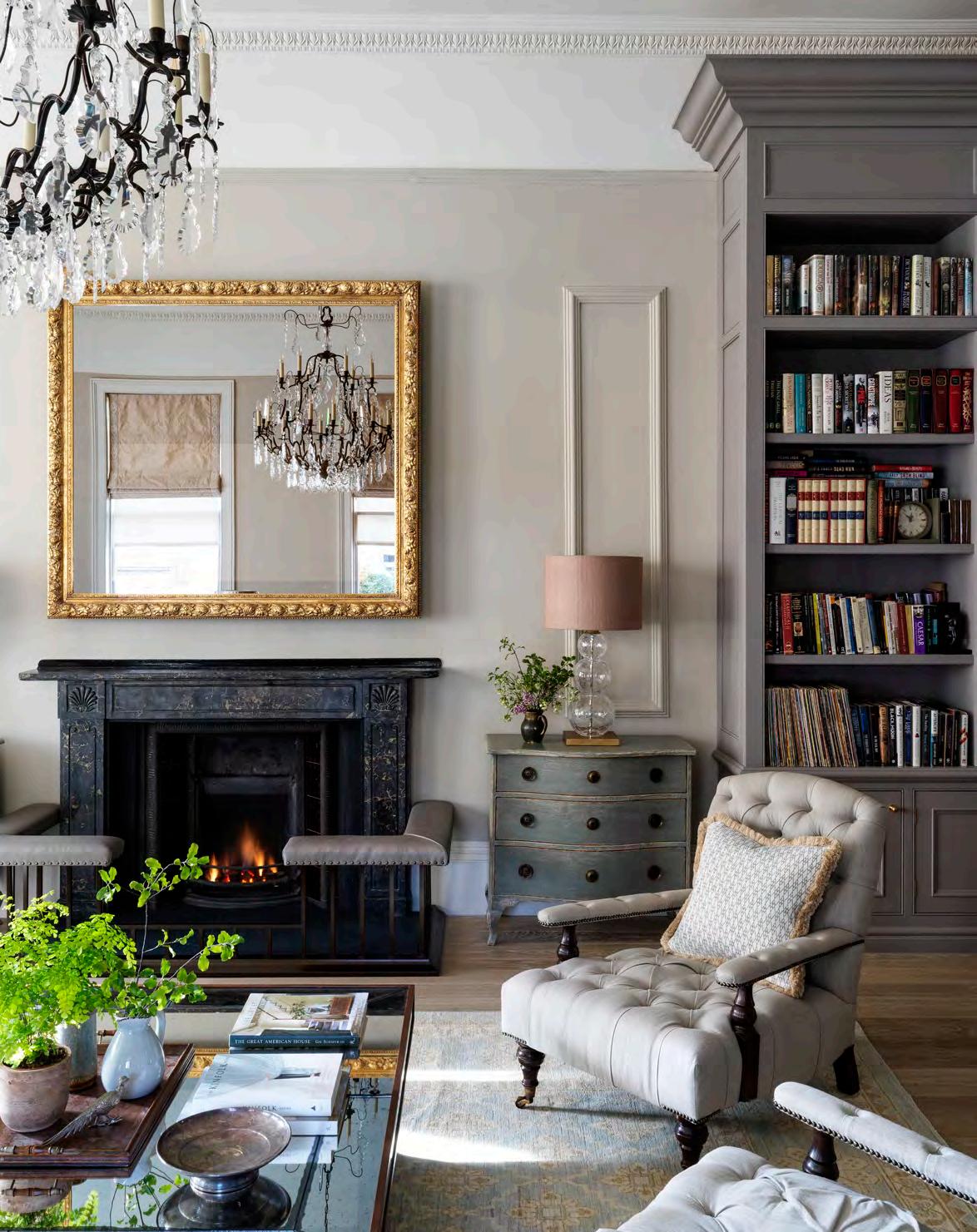
What is the essence of English decorating in today’s world? Samantha ScottJeffries, editor of The English Home, talks to interior designer and Neptune’s creative founder Emma Sims-Hilditch about her new book which addresses that very question.

Home. A place that inspires our daily lives, makes us feel happy and provides us with our own unique sanctuary. The events of the last three years have accelerated a shift in how we’ve come to shape and decorate our living spaces and our homes have taken on a renewed significance, with many roles to play. We look to our homes to provide an energising environment for work, calm spaces for relaxation and convivial areas to enjoy with friends and family. Creating homes that deliver all we require of them today has many of us looking to experts for advice.
The Evolution of Home, English Interiors for a New Era – a new book by Emma Sims-Hilditch and co-author Giles Kime – offers inspiration and ideas to help us create English interiors for how we live now. Organised by pursuit (eating, sleeping, bathing), projects by the Sims Hilditch design team offer beautiful and considered solutions to comparable spaces “helping people take what we’ve learnt over 25 years of interior design, distil and use that information,” Emma explains.
“So many of the properties we’ve worked on are historic buildings which weren’t originally designed for how we live now,” says Emma of the homes featured in the book. She cites tiny, windowless kitchens and a lack of en-suite bathrooms as examples. “In the initial planning phase of every project we look holistically at the space, the aspect of each room, where it is located and start from scratch,” explains Emma. “The space comes first, before the aesthetic.”
e Evolution of Home, English Interiors for a New Era, by Emma Sims-Hilditch and Giles Kime, is published by Rizzoli.

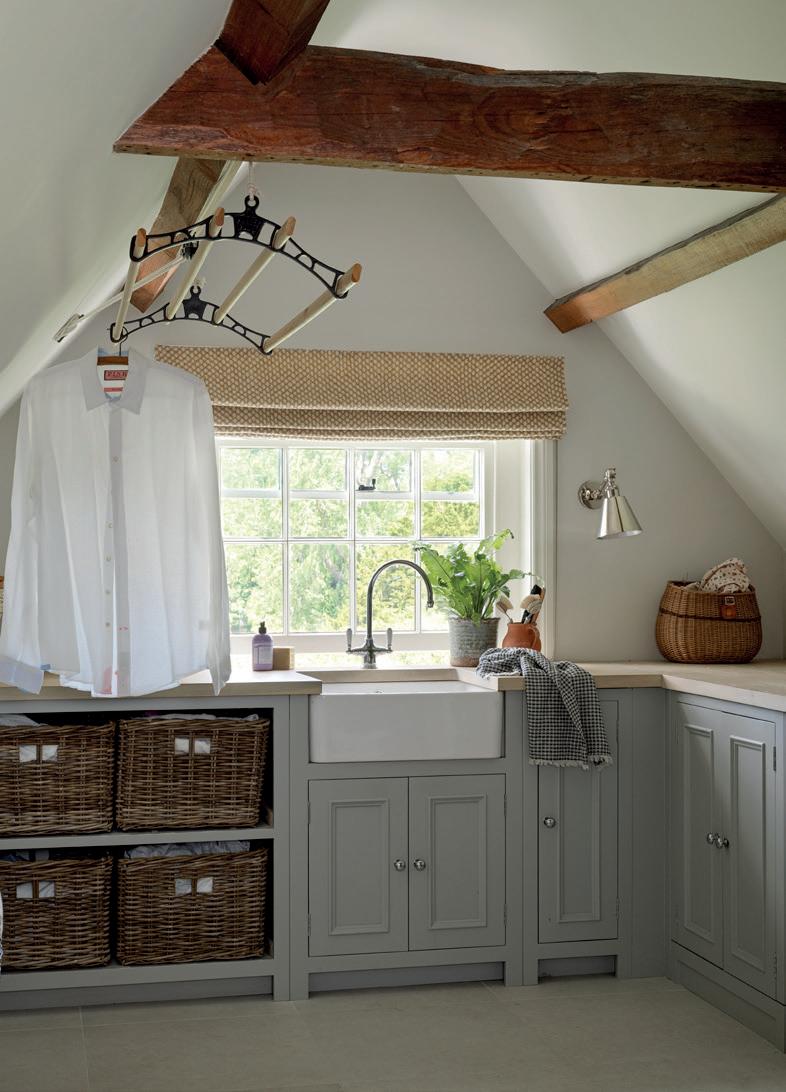
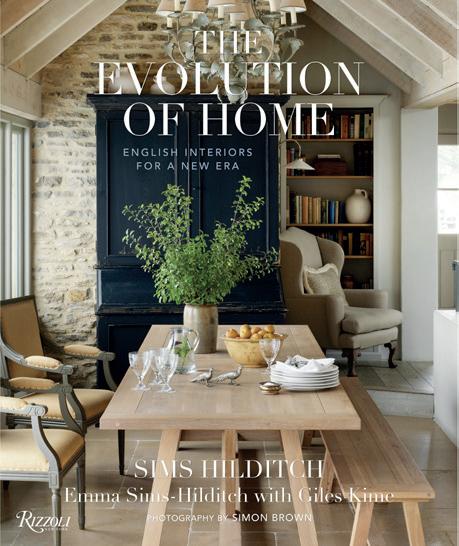

How rooms function in terms of practicality and comfort are key, a sentiment also at the very heart of classic English decorating. The evolution of this in today’s world, says Emma “is the idea that the owners of a home want every space to feel special. The utility room, the laundry room, all these rooms have become aggrandised. What was once the TV room is now the cinema room. The larder is more than a cupboard, we want it to be beautiful.”
Spending more time in any room shapes our expectation of it. “Our clients prefer home offices to feel more like a sitting room than a study, with upholstered furniture. They want a beautiful mid-century desk and a painting to hang above it,” explains Emma. For the many who need an occasional workstation in a multifunctional space, “bespoke cabinetry is a good investment.” She recommends desks which can be stowed away to look like a classic piece of furniture when not in use. She’s used the Chichester workstation and the Chawton collection, both by Neptune, to achieve this in her projects. These timeless, investment pieces “don't date and – if they are painted originally –they can be repainted” when an update is required.
A refreshing take on classic English decorating is at the heart of the SimsHilditch aesthetic. Comfort, cues from nature, reusing established materials or antiques and adding character all feature. Authenticity and a relaxed approach are how these elements have been developed by the design studio for the new era. Emma loves to mix brown furniture with quality new pieces for example. “It feels so much more authentic to blend periods of furniture – if you have a bed with a bedside table, they don’t have to match.” Similarly, her schemes show that symmetry is sometimes desirable but “it can be more arresting or interesting when not everything is a mirror image,” and useful “if the room won’t allow it.”
When asked what the next step might be for our homes, she replies, “sustainability. The big evolution is about buying once and buying well (as is the Neptune philosophy) rather than ‘fast interiors.’ Designing for longevity consciously, and creating interiors that will last a long time.”
Celebrating a new take on timeless style may feel incongruous to some with the concept of a home for a new era, yet it is, in fact, forward thinking.
MEET AALISH YORKE-LONG, NEPTUNE'S FIRST CEO, WHO JOINED THE BUSINESS IN NOVEMBER 2022.
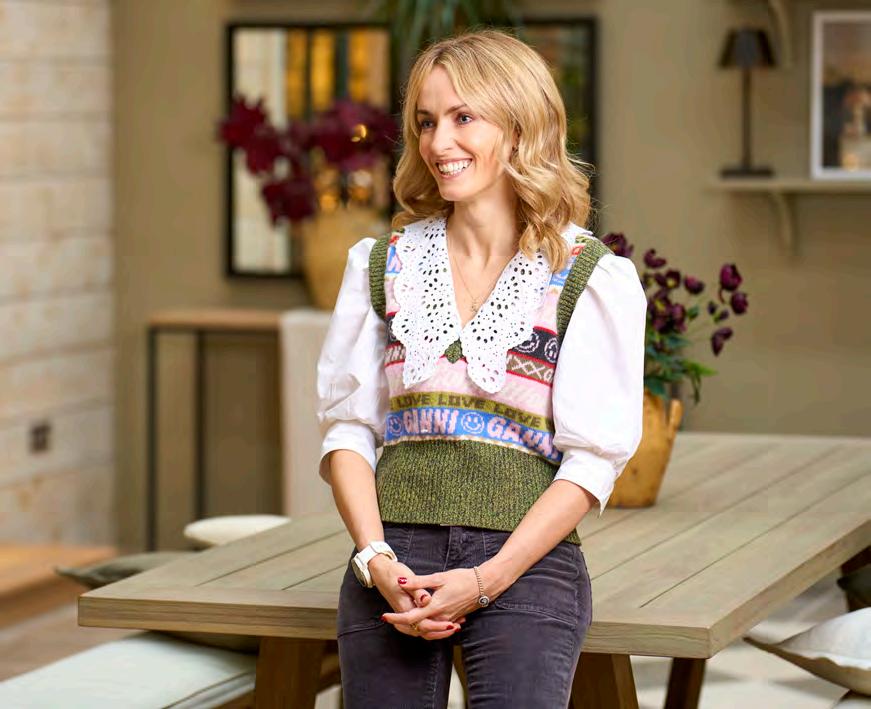
Welcome to Neptune, Aalish, have you always worked in the furniture business?
No, I intended to be a lawyer but quickly realised that it wasn’t for me, so I segued into retail. I started working in a little shop in Chelsea where I discovered I loved e-commerce and building websites. Most recently I set up the retail function for Soho House. I got to build the business up from scratch, before joining Neptune.
You arrived in November last year, what have been your first impressions?
I’m struck by the thoughtfulness and intention of the business: every single aspect has been thought about, from every angle, and that approach comes from the founders. Hearing John Sims-Hilditch talk about how they designed the first cupboards based on the interiors of a sailing boat, to make the most of every inch of storage, was amazing. So, it’s a huge privilege to be working with them to develop the next chapter in Neptune’s history.
And what do you think makes Neptune stand out?
Our main point of difference is our 100 year vision. Everything we do is designed to last 100 years or more. Every detail is carefully considered, whether that’s the product, the design, or the service.
How does a desire for sustainable furniture fit into this approach?
Sustainability is part of every conversation we have. A sustainable product is one that lasts a long time, which is at the heart of what we do at Neptune. But it covers every area from packaging, where we manufacture, and where we build our stores.
And talking of stores, have you been visiting them?
Our stores are our greatest assets; the teams are incredible, and the services we offer – the kitchen design service, the home design service and now the colour consultancy – are second to none. Neptune’s stores are unique – it’s like walking into someone’s home. On my recent visit to York, the store leader greeted me with a freshly baked cake. It felt like he was hosting me at home.
What does the future hold?
Since the pandemic, customer behaviour has changed. Customers expect even more from retail today. Shopping has to be more experiential, and the service level has to be much higher. It’s exciting for Neptune because service is one of the things we’re very good at.
And finally, is it too early to have a favourite piece from our collection?
My favourite piece is easy! I’m redesigning the kitchen of the farmhouse I share with my husband and two small children, and I love the materiality of the Henley kitchen and its design features. It feels incredibly fresh and modern.
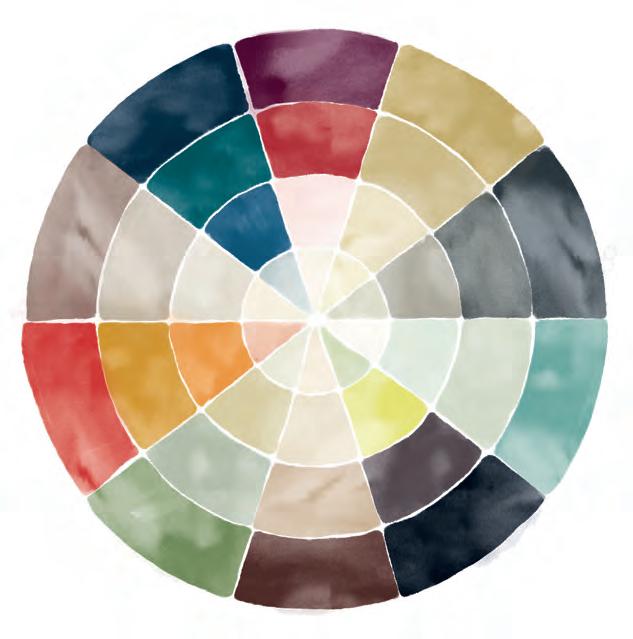
Many moons ago (in our third volume of Stories, in fact), we wrote about our bespoke design service. It was something we’d nurtured and grown and wanted to shout about from the rooftops. Now, in much the same way, we put pen to paper to launch our new design service, the colour consultancy.


If you’re embarking on a home project, however big or small, and choose to design one or more of your rooms using the Neptune Home Design Service, paint is part of the package. But what if you only want help with picking your paint palette – be it for your walls, cabinetry, woodwork, or even your paintable pieces of furniture? That’s where our newly launched Colour Consultancy Service comes in.
“We’re so often asked by our customers for advice on choosing paint colours,” Simon Temprell, Neptune’s interior design manager (and the mind behind our Home Design and Colour Consultancy Services), tells us. And it’s really no surprise. Paint is, after all, one of the most straightforward – and powerful – ways of transforming any space. “Paint can alter the way that
you view a room architecturally. It can completely change the focal point,” says Simon. “You can also disguise problems in the room and emphasise things that are beautiful.”
Neptune is all about a carefully curated, edited choice and the paint collection reflects that. It was something we had to consider when we first started talking about the service. Could we create a consultancy using a palette of about fifty shades? The answer was a resounding yes: “A curated library certainly doesn’t mean we can’t be adventurous, or creative, with our selections,” enthuses Simon. Indeed, as Neptune Knutsford’s home specialist and all-round colour expert Chrissy Culverwell puts it, “the true beauty of our paint colours lies in their combinations.”
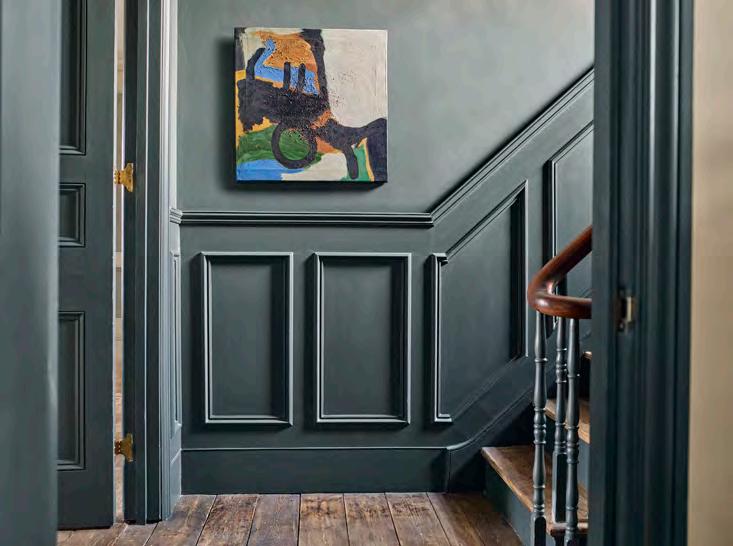
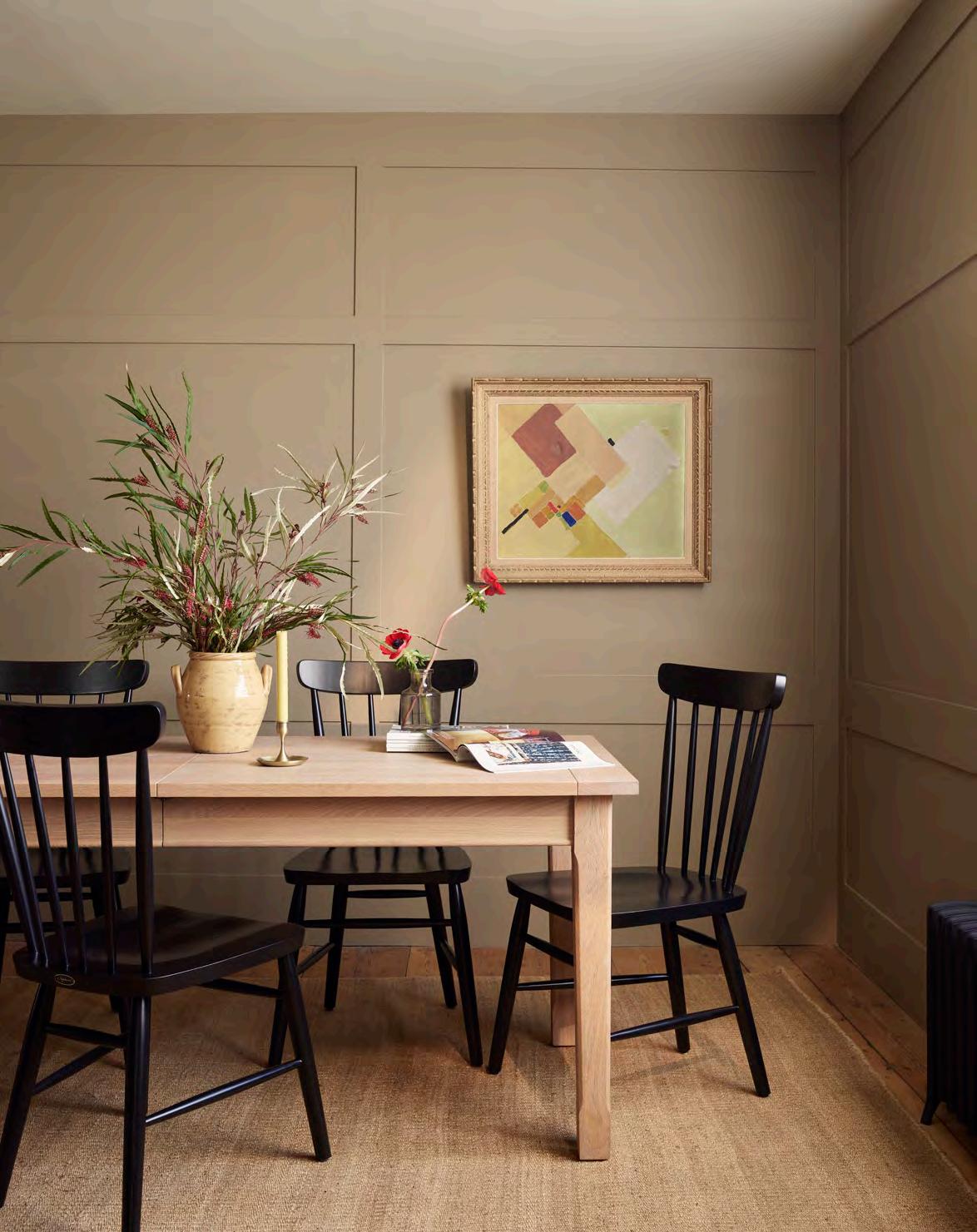

For a fee of just £200, you’ll benefit from expertly chosen palettes for four of your rooms (if you’re looking for help with more than four rooms, it’s a £50 hourly fee thereafter). It all begins with a brief, initial consultation which can be done over the phone or in store.
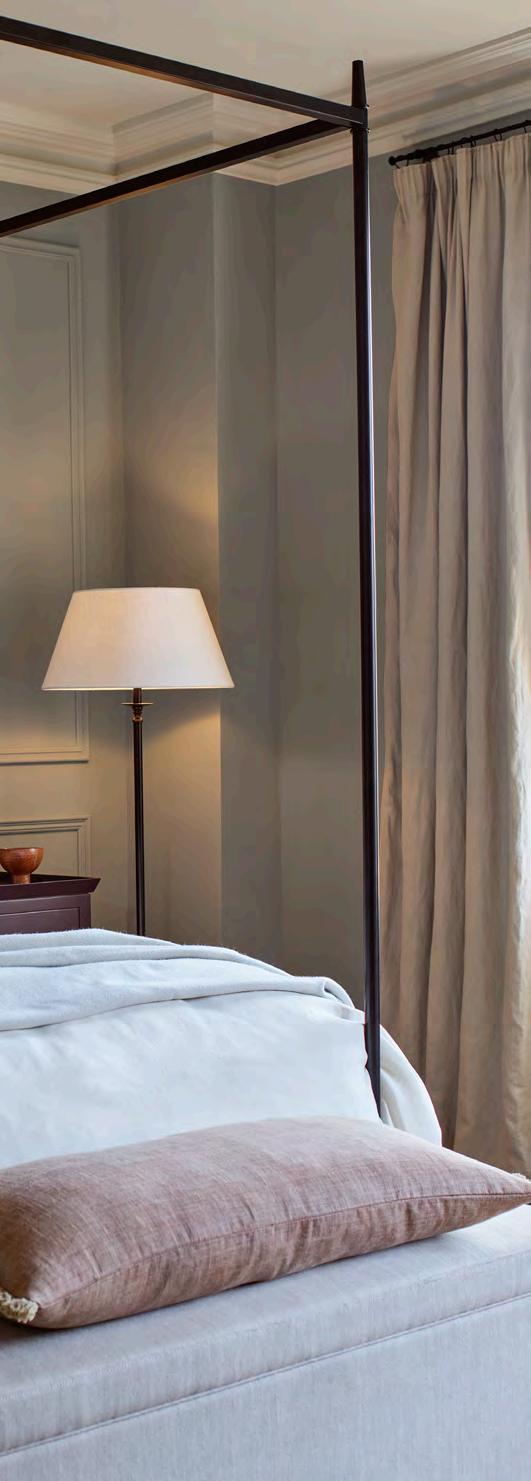
An hour’s at-home design visit follows – this is when the consultant compiles their paint choices, taking into consideration the shape, size and architecture of the rooms, and the quality and amount of natural light.

The service culminates with the creation of a comprehensive painting plan, detailing colour choices (and the proposed whereabouts of each shade), paint types, and amounts. This is your decorator’s handbook; to be passed directly on to the experts working on your project, or to be kept close to hand if you’re taking full control of the reins from this point onwards.
For more information, visit neptune.com/colour-consultancy
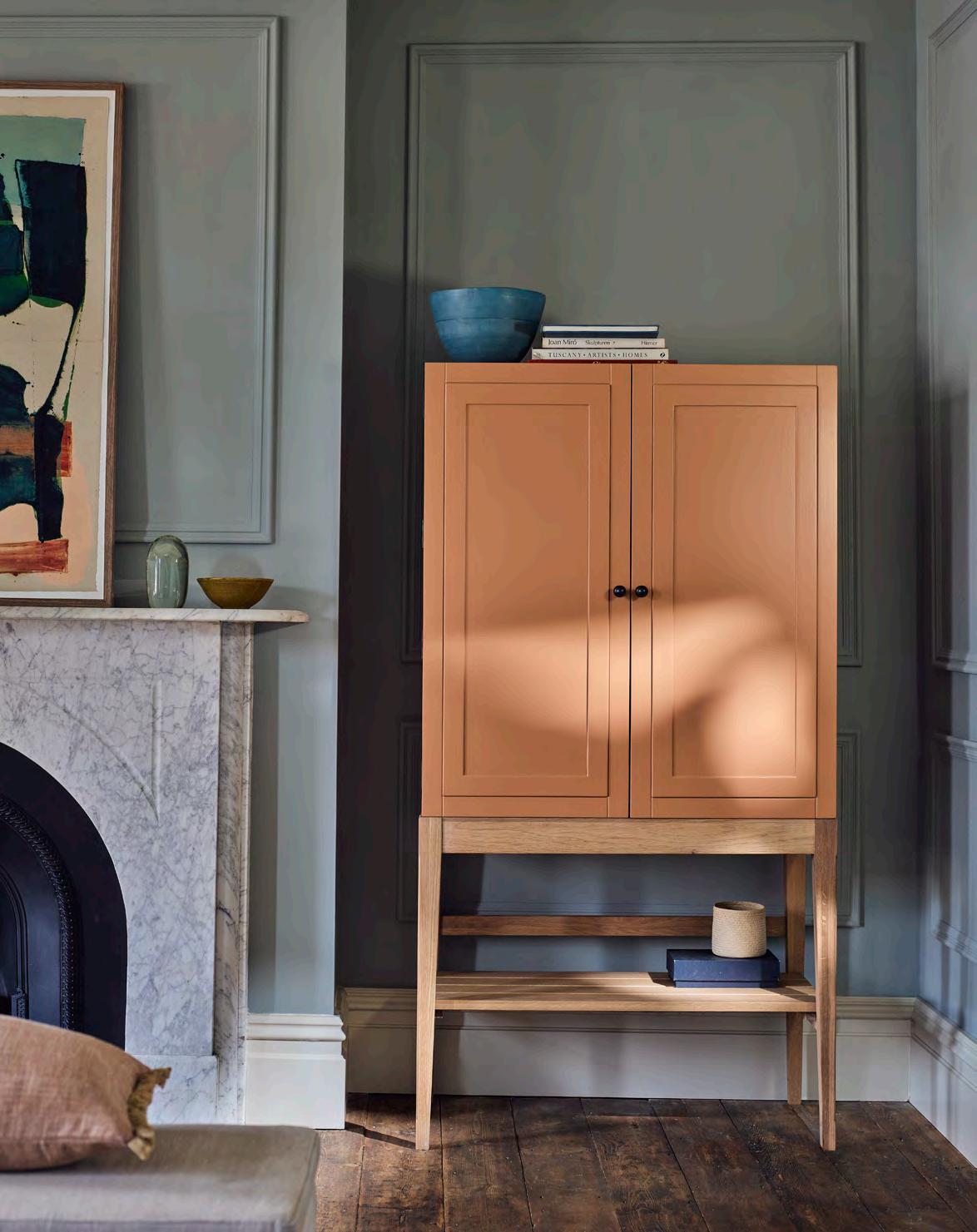
This is
Named after West Sussex’s famed antiques fair, this is storage that’s rooted in classic design. Behind Ardingly’s smart exterior, you’ll find dimmable lighting, adjustable shelves, and discreet cable management. Choose to include a mirrored back and a Carrara marble surface to create a luxurious dressing table or drinks cabinet. We’ve also imagined it as a coffee station, a larder, or a home office piece. How will you use Ardingly?
LAURIE TIMPSON’S PASSION FOR COMBINING CRAFTSMANSHIP, TECHNOLOGY AND THE BEST POSSIBLE MATERIALS HAS GIVEN BIRTH TO A REVOLUTIONARY BRITISH KNIFE.
What distinguishes a purely functional object from one with which you have an emotional connection? Does it have to be beautifully conceived? Painstakingly fashioned? Made from the best possible materials required for the job? Completely fit for purpose? Without a doubt, it’s all those things.
Yet those are by no means the only criteria that ensure an object transcends mere functionality. It also must have the capacity to age; a process that, in time, will allow you to establish a bond. For chefs, a good knife is certainly more than just an object, it’s a tool that magically transforms their hands into a precision instrument. It’s an activity that’s at the heart of what chefs do. ‘A kitchen without a knife is not a kitchen,’ said Masaharu Morimoto, the Japanese chef and star of the US TV series, Iron Chef. And there are plenty of knives from which to choose, from the most rudimentary to those that are so poised, so perfectly balanced, and so beautiful to behold, that they make you want to take up cooking immediately, even if you have done little more in a kitchen than stir a cup of tea.
Yet what might make you want to take up making a knife with all those credentials? For Laurie Timpson it was the satisfying challenge of making an axe for chopping kindling (an important activity when you live off grid in the wilds of Wiltshire with your wife and three small children). Having spent months fashioning an axe by hand, Laurie decided to create a chef’s knife that met his own exacting demands. Seven years later, his knives also meet the exacting demands of Tom Aikens, Tom Kerridge and Margot Henderson amongst others.
He’s a man who relishes a challenge; after five years in the Scots Guards, he set up emergency relief programmes in Southern Sudan and Ethiopia, as well as working with the HALO Trust to clear landmines in Mozambique. It was an experience that taught him that patience and persistence can achieve most things. Another thing he learnt was that if you want to get things done you need the right kit – and there was no doubt in his mind that stainless steel was the only material with the capacity to deliver the best performance possible.
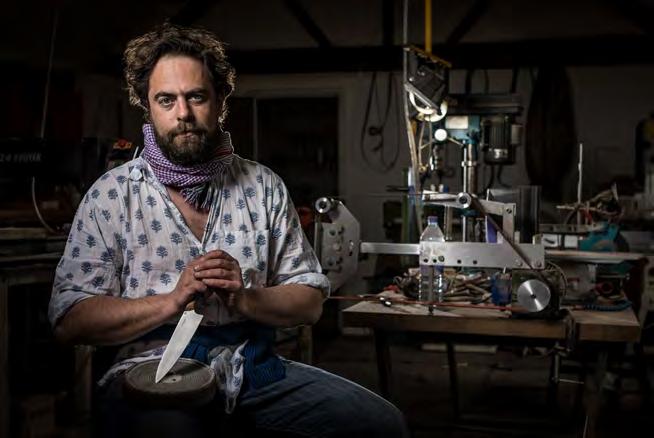

Experience of dangerous situations also teaches you the value of technology and Laurie recognises the importance of harnessing its power and bringing it to life alongside the artisanal skills of his ten-strong team who work at the company’s HQ in a former sawmill, deep in the Savernake Forest. The blades are milled in a micron-precise CNC machine (the same type used by Formula 1 engineers), the start of a 42-stage process that takes over 50 hours to complete. It’s a sequence that transforms the steel into both a precision instrument and a thing of beauty – as does the addition of the sculpted handle, made from a choice of woods such as English Walnut or Yew, or a cutting edge material such as Corian and Richlite.
Choosing a Savernake knife offers a wealth of opportunities to create a bespoke design that exactly fits your specification. As Laurie says, “there’s no such thing as the perfect knife but we can almost certainly make your perfect knife”.

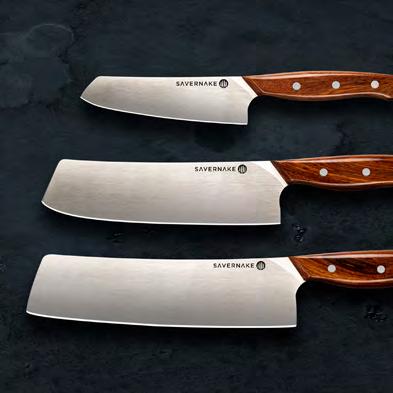
There is white and then there is white, as journalist Jo Rodgers discovered when she embarked on choosing paint colours for her renovation project
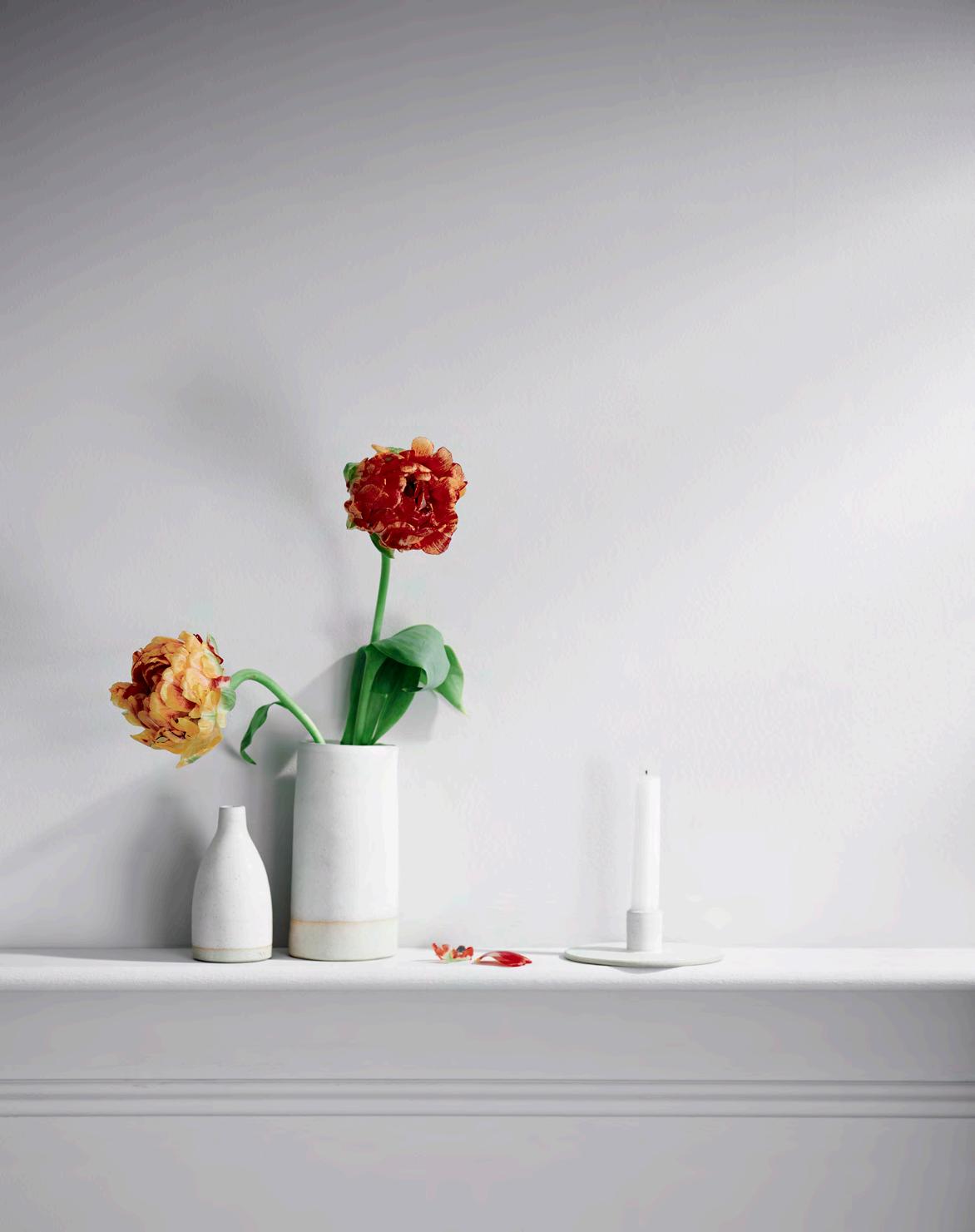
Our builder Howard, who helped us with our flat in Islington, had nightmares about the painting plan. There were five different shades of white: creamy white for the ceiling and gloomy white for the stairs, biscuity white for the cornicing and buttery white on the walls. There was a middle-of-the-road white on the exterior window frames, but on the interior frames, it was biscuity again. The bedrooms and bathrooms were a run of blues –inky; pale; greenish at certain times of day – with peeps of black-blue throughout, in places like the backs of bookshelves and the spindles of the staircase. There were, additionally, four different undercoats to buck up these colours, apart from on the radiators (painted to match the walls), where an undercoat should absolutely not be applied. Every time Howard went home, we wrung our hands.
It will not surprise you that this scheme did not come from me. Back then it would not have occurred to me that the ceiling might be a different colour than the walls. I was operating from a vague position that London is a busy place, and wouldn’t it be nice for the flat to feel calm. So, one day I walked over to the nearest paint shop and showed a shop assistant – we’ll call her Mary – the bluishwhite paint I’d picked out on their website. I wanted her to help me approximate how many pots we would need.
“What kind of house do you have?” Mary asked, and I told her it was part of an early 19th century one. Her face fell. The paint I’d chosen was a modern white, ideal for art gallery walls or maybe storage units. She asked what I was thinking about for the kitchen, the bathrooms, and the various trims, and I replied that they would be the same blueish-white. The longer this conversation went on, the more I could see Mary was getting worried about the gallery-stroke-storage-unit that my husband and I, plus our new baby, were planning to live in.
We were taken in hand. In a few weeks we had a painting plan, and eventually we moved in. The playfulness of the result was shocking to us: tranquil not boring, rich not loud, allowing for the quirk and personality of the house. We insisted to friends, in deadly serious voices, that the paint was the most impactful decision we made in a soup-to-nuts renovation. The place felt finished. Around 25 minutes after that we realised we were having second baby and moved out.
Now we have a small house near the Thames that needs painting. Howard doesn’t want anything to do with it.
Discover our new Colour Consultancy Service on page 30.
Light and delicately balanced, Spring’s verdant garden produce offers a chance for unexpected combinations and refreshing flavours. Rhubarb, asparagus and artichokes reach their peak this season so bring some seasonal colour and taste to the table with these tempting recipes devised by Sarah Jane Bellmaine, Neptune’s lead chef at The Provenist.
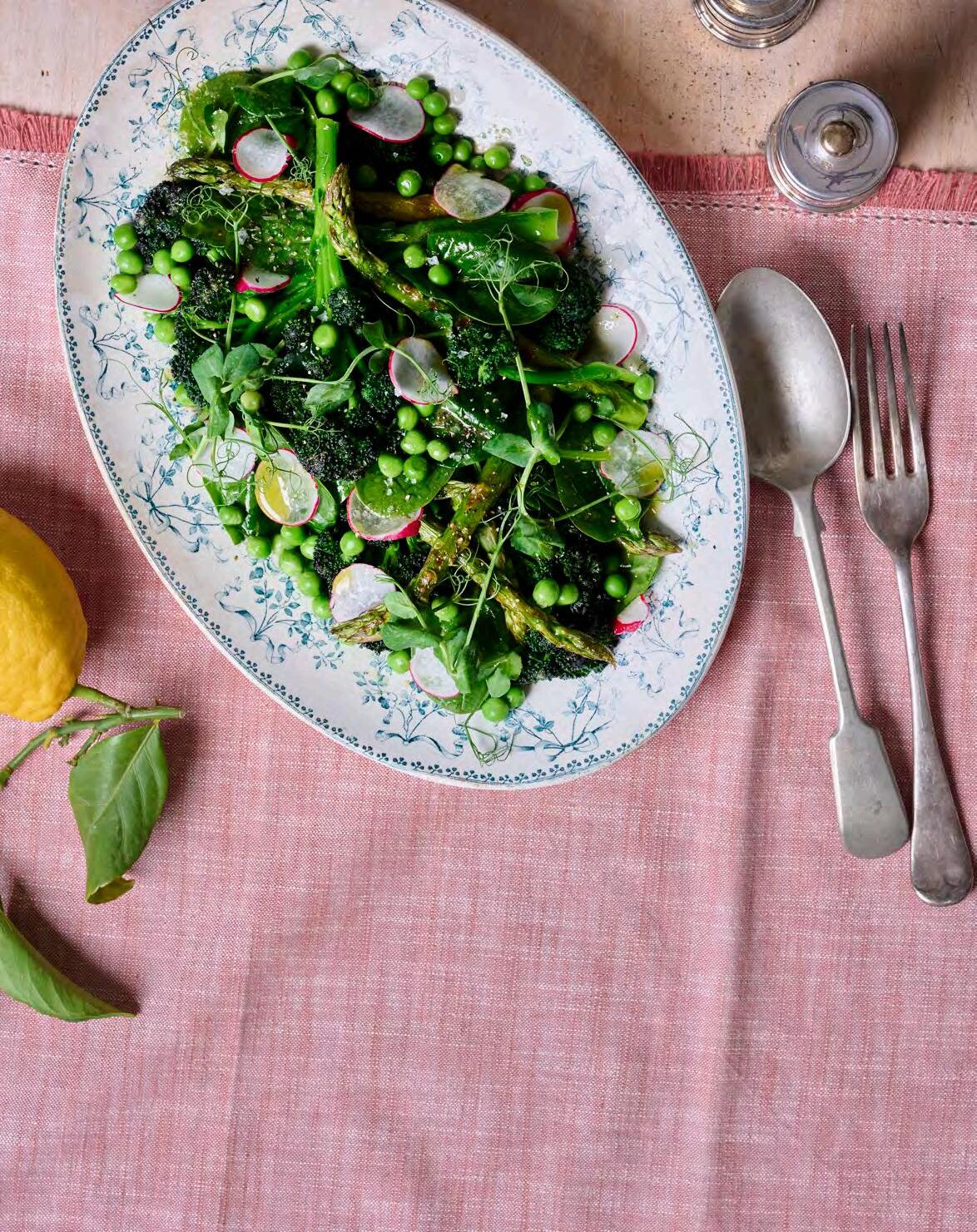
Makes enough for six to eight
For the salad
150g asparagus, rinsed
150g purple sprouting broccoli, rinsed and trimmed
100g frozen peas
60g baby spinach, rinsed and dried
For the dressing
5g fresh mint, rinsed
15ml lemon juice, freshly squeezed
45ml good quality extra virgin olive oil
1 small garlic clove, peeled

Sea salt and freshly ground black pepper
1 Begin by preparing the asparagus. Trim or snap off the woody ends, drizzle with a little olive oil and season. Meanwhile, heat a griddle pan over a high heat. Add the asparagus and cook for 3-4 minutes on each side until lightly charred and tender. Remove from the pan and set aside.
2 Next, blanch the broccoli in a pan of lightly salted water for 2 minutes, then drain and refresh under cold water.
3 Bring another pan of water to the boil and simmer the peas for 3 minutes, or until tender. Drain and set aside.
4 Now make the dressing by blitzing together all the ingredients in a blender or food processor until smooth and emulsified.
5 A rrange the salad ingredients in a dish and drizzle over the dressing. Serve immediately.
Makes enough for twelve
500g block puff pastry
1 large leek, rinsed and thinly sliced 400g artichoke hearts, drained and sliced 300g feta, crumbled
10 free range medium eggs
2 pints whole milk
Sea salt and freshly ground black pepper

1 Preheat your oven to 170°C fan and line the base and sides of a 30cm loose-bottom tart tin with greaseproof paper.
2 Roll out your block of puff pastry to 2mm thickness and gently press into the base and sides of the tin, allowing any excess to hang over the sides. Line with greaseproof paper and fill with baking beans.
3 Blind bake your tart case for 25-30 minutes, until golden. Take out of the oven and remove the baking beans and greaseproof paper. Set aside, leaving the oven on.
4 Heat a little olive oil in a frying pan and add the leek. Season and cook for 5 minutes.
5 Transfer the artichokes, cooked leeks and crumbled feta into the pastry case.
6 Beat the eggs and milk together with a pinch of sea salt and freshly ground black pepper. Pour into the case.
7 Bake for around 45 minutes, or until set. Take the quiche out of the oven and allow to cool slightly before removing from the tin and cutting into slices.
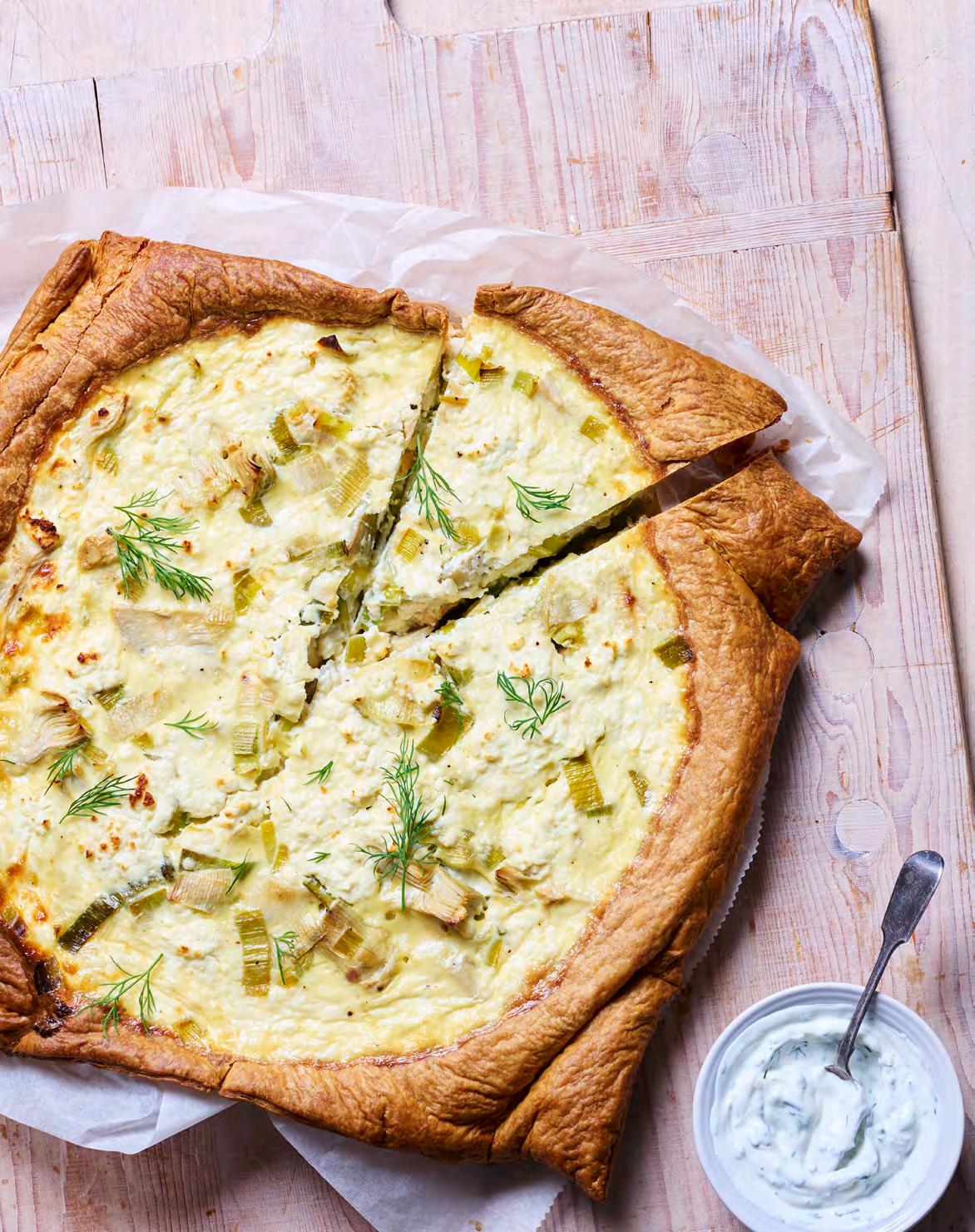
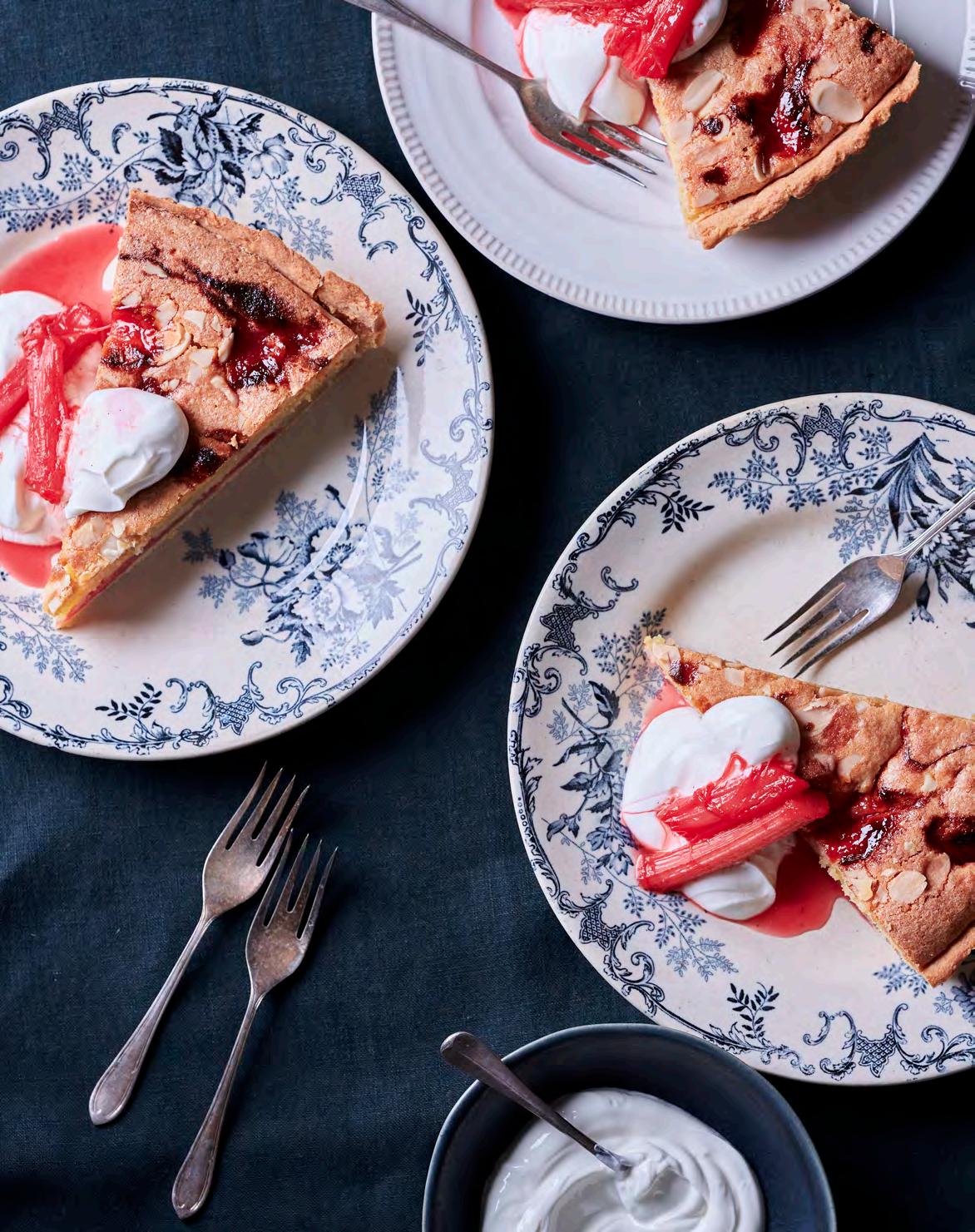
Makes enough for twelve
For the sweet pastry

340g plain flour
170g salted butter
85g caster sugar
1 large egg
For the sugar syrup
150g caster sugar
150g water
1 vanilla pod, split in half
For the filling
400g rhubarb, rinsed, trimmed and cut into 5cm pieces
3tbsp rhubarb jam
280g salted butter, softened
280g caster sugar
5 medium eggs
250g ground almonds
50g self-raising flour
Handful of flaked almonds, to decorate WHAT
1 To make the pastry, blitz or rub together the flour, butter and sugar until they resemble breadcrumbs. Mix in the egg and quickly bring together using your hands to form a dough. Wrap in clingfilm and rest in the fridge for 1 hour.
2 Preheat your oven to 160°C fan and line the base of a 30cm loose-bottomed tart tin with greaseproof paper.
3 Roll out the pastry on a floured surface to the thickness of a pound coin and carefully press into the base and sides of the tin. Line with greaseproof paper and fill with baking beans.
4 Blind bake for 25-30 minutes until the pastry is light golden. Take out of the oven and remove the baking beans and greaseproof paper. Set aside, leaving the oven on and adjusting the temperature to 140°C fan.
5 Make your syrup by boiling the sugar, water and vanilla for a few minutes. Meanwhile, place your rhubarb on a baking tray. Pour the syrup over the rhubarb and cook in the oven for 15 minutes, or until soft. Remove from the oven and allow to cool before draining off the excess liquid.
6 Now for the frangipane. Beat together the softened butter and sugar until well combined, then add the eggs one at a time. Mix in the ground almonds and flour.
7 To arrange the tart, start by spreading the jam over the bottom of the pastry case, then layer with the drained rhubarb. Finally, top with the frangipane, carefully smoothing it out with the back of your spoon or a palette knife, and sprinkle with flaked almonds.
8 Bake at 160°C fan for around an hour. Take the tart out of the oven and allow to cool slightly before removing from the tin and cutting into slices.
Author Isabella Tree selects four books about trees that have influenced her journey as a conservationist as she and husband Charlie Burrell lead the rewilding project Knepp Wildland, in the grounds of their West Sussex home, Knepp Castle.
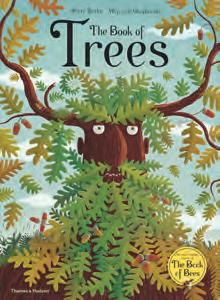

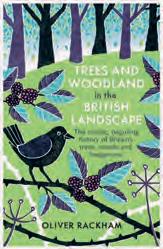

Meeting the extraordinary tree expert, Ted Green, inspired us to rewild our farm. Our ancient oaks were dying, he told us. We were ploughing up their roots and poisoning them with agrochemicals. We had no idea. Now, much of our work is about restoring trees, allowing them to regenerate naturally within the protection of thorny scrub. Far better for wildlife than planting, and healthier for the trees themselves. The survival of trees, we now know, is tied to our own – as is my name!

Suzanne Simard
(Allen Lane, 2021)
Canadian scientist Suzanne Simard was originally ridiculed by the scientific community, but it was her work in the forests of British Columbia that revealed the extraordinary, invisible web of roots and fungi through which trees communicate and sustain each other. Simard was the inspiration for the central character in Richard Powers’ 2018 Pulitzer Prizewinning novel The Overstory.
Oliver Rackham
(Orion Books, first published 1976; revised 1990)
This classic by legendary tree ecologist Oliver Rackham is both scholarly and eminently readable. It charts Britain’s treescape from the Romans through the Middle Ages to the present day. It works both as a fieldguide, explaining the character of individual trees, and as a work of cultural history, presenting trees holistically, as the backdrop to our changing landscape.
Julian Hight
(Self-published, 2015)
Designer, photographer, musician, and author of Britain’s Tree Story for the National Trust, Hight’s World Tree Story is the fruit of a five-year odyssey to photograph 100 historic trees, some more than a thousand years old, in 39 countries. Beautifully illustrated, with stunning archive photographs and engravings, it reads like an arboreal Arabian Nights.
Piotr Socha (Thames & Hudson, 2018)
This stunning, large-format picture book by awardwinning Polish illustrator and son of a beekeeper, Piotr Socha, is aimed at 7 to 9-year-olds. It’s a fascinating read for adults, too. It feels like an oldfashioned children’s encyclopaedia but contains a rich tapestry of modern ecology, cultural history and global tree facts.
Isabella’s best-selling book ‘Wilding’ tells the story of how she and her husband, conservationist Charlie Burrell, rewilded their farm. Her latest book, ‘The Book of Wilding –a practical guide to rewilding, big and small’ is published by Bloomsbury on May 11, 2023.

As an interior designer and Neptune’s creative founder, Emma Sims-Hilditch has set the colour palette and vision for the company for over 15 years with her unerring eye for the most beautiful hues and shades to live with. Here she suggests some fail-safe paint combinations for different types of room, depending on aspect, atmosphere, and mood.
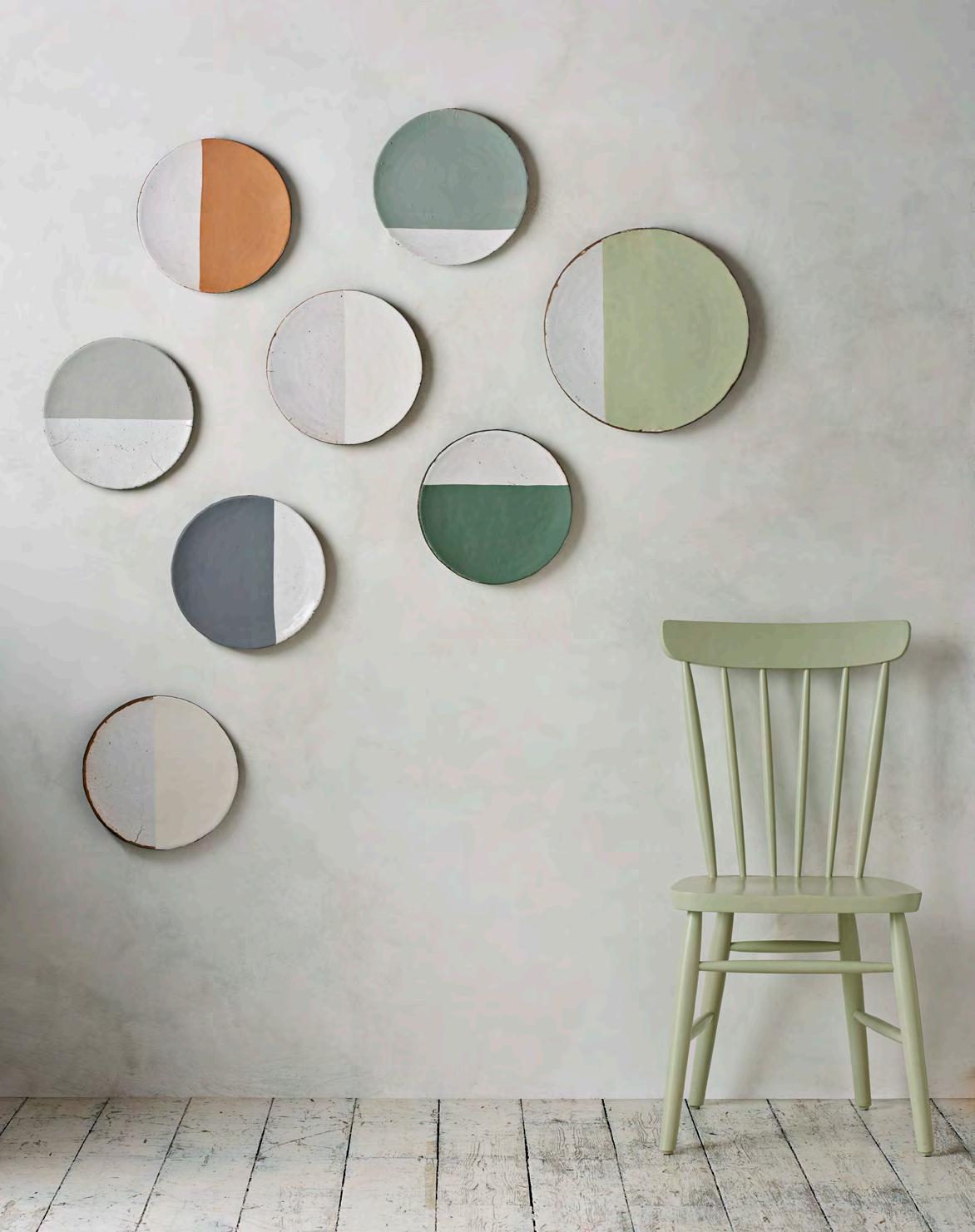
For an inviting dining room scheme that will work just as well for Sunday lunch as it will for a smart dinner party, I’d suggest using Burnt Sienna on the walls with Cotswold on the joinery and skirting, and the mellow creaminess of Old Chalk on the ceiling and cornicing. The dark woods of antique furniture or the deep hues of a classic tapestry will work beautifully with this scheme, while the gilt frames of mirrors or paintings will pop off the Burnt Sienna walls.
A relaxing bedroom needs gentle colours that don’t feel cold; blues and greens are often recommended for bedrooms as they promote a sense of tranquillity and are good for inducing sleep. Mist is a soft blue-grey with a warm undertone and would work beautifully on bedroom walls, along with Shell on the ceiling and the woodwork. You can inject colour highlights through fabrics and bedlinen.
Pink is a fun – and slightly unexpected choice – for a busy bathroom, but its flattering tones mean it’s a favourite at any time of night or day. It feels smart but not austere. I’d recommend using the comforting, warm Old Rose on the walls (either in paint or with our Barbury tiles), painting the ceiling in Snow and using a neutral like Lily for the woodwork and joinery.
If you’d like your workspace to feel moody and dignified, try Teal on the walls and the room’s joinery, then introduce Clove as an accent colour on a sideboard, dresser, or the internal walls of a bookcase, with Dove Grey on the ceiling. For a fresher feel, you could swap in Dove Grey on the woodwork and retain Clove as an accent on furniture. Complete the scheme with a wool plaid fabric for upholstery and curtains that pull the Teal and Clove shades together.
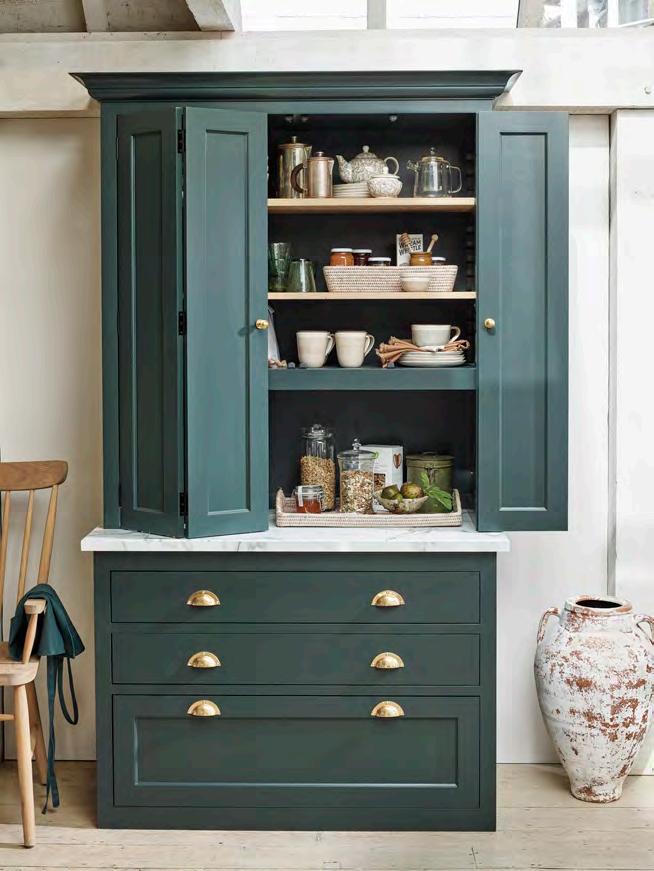
Constable Green + Siver Birch + Shell
Green is a great choice for kitchens thanks to its association with plants and vegetables. For a strong, smart look which has a modern classic feel, I would opt for an historic dark shade like Constable Green on cabinetry. Then add the soft grey of Silver Birch on walls and woodwork and use a lighter shade like Shell on the ceiling.
Saffron + Fog + Shell
I love the combination of yellow and grey. In a hallway (particularly if it’s a fairly dark, small or uninviting one), try a rich yellow like Saffron on the walls to add warmth and depth. Combine it with Fog, a classic grey, on the woodwork and Shell on the ceiling to create a smart but impactful welcome.
Country
French Grey or Cactus + Aqua Blue
Town or city
Shell + Shingle + Aqua Blue + Sage
Green and grey shades work well outdoors and won’t distract the eye from the surroundings. On stone country houses, try the heritage grey-green of French Grey or Cactus on woodwork –window frames, doors and garden furniture – then add an unexpected shade like Aqua Blue on a bench, garden gate or planter. For a town or city property, I’d suggest painting the masonry walls in Shell, using the pale grey Shingle for the windows and Aqua Blue for the front door. You could add a bench in Sage as an accent colour.
Lily + French Grey + Moss + Cactus
Don’t think of rooms in isolation, as you’ll often have vistas from one room to another and the eye should travel smoothly between the spaces. You could consider using analogous colours, which are a group of hues positioned next to each other on the colour wheel (handily, our signature palettes consist of analogous colours which make picking a scheme much easier). Build the colour gradually – start with the lightest colours in south facing rooms, say Lily followed by French Grey. As you move through into darker rooms that are north facing, embrace the lack of light by using darker colours like Moss and then Cactus for a cosier, enveloping feel in a snug or sitting room.
Driftwood + Rhubarb | Navy + Saffron | Shingle + Quince
Revealing colour in the flashes of an opened cupboard or the recess wall on a bookcase is useful when you want to keep the mood calm but still add interest. Try painting a cupboard in a soft putty grey like Driftwood and then covering its internal walls in our new warm coral shade Rhubarb, or paint the frame and shelves of a bookcase in smart Navy and use Saffron on the interior back wall as a foil for books. I also adore the unexpected combination of Shingle on all kitchen cabinetry with Quince on an island or dresser.
To identify your perfect scheme, start with a painting you love and analyse the palette that the artist has mixed because you’ll know those colours work together. Then spread those shades out across your home. I’m currently creating schemes based on oil paintings by 1950s Scandinavian artists, which I found at the Panter & Hall gallery in London, as their colours work so well in our northern hemisphere light.
Our new Colour Consultancy Service guides you in curating a Neptune paint palette that’s tailored to your home. Read more on page 30.
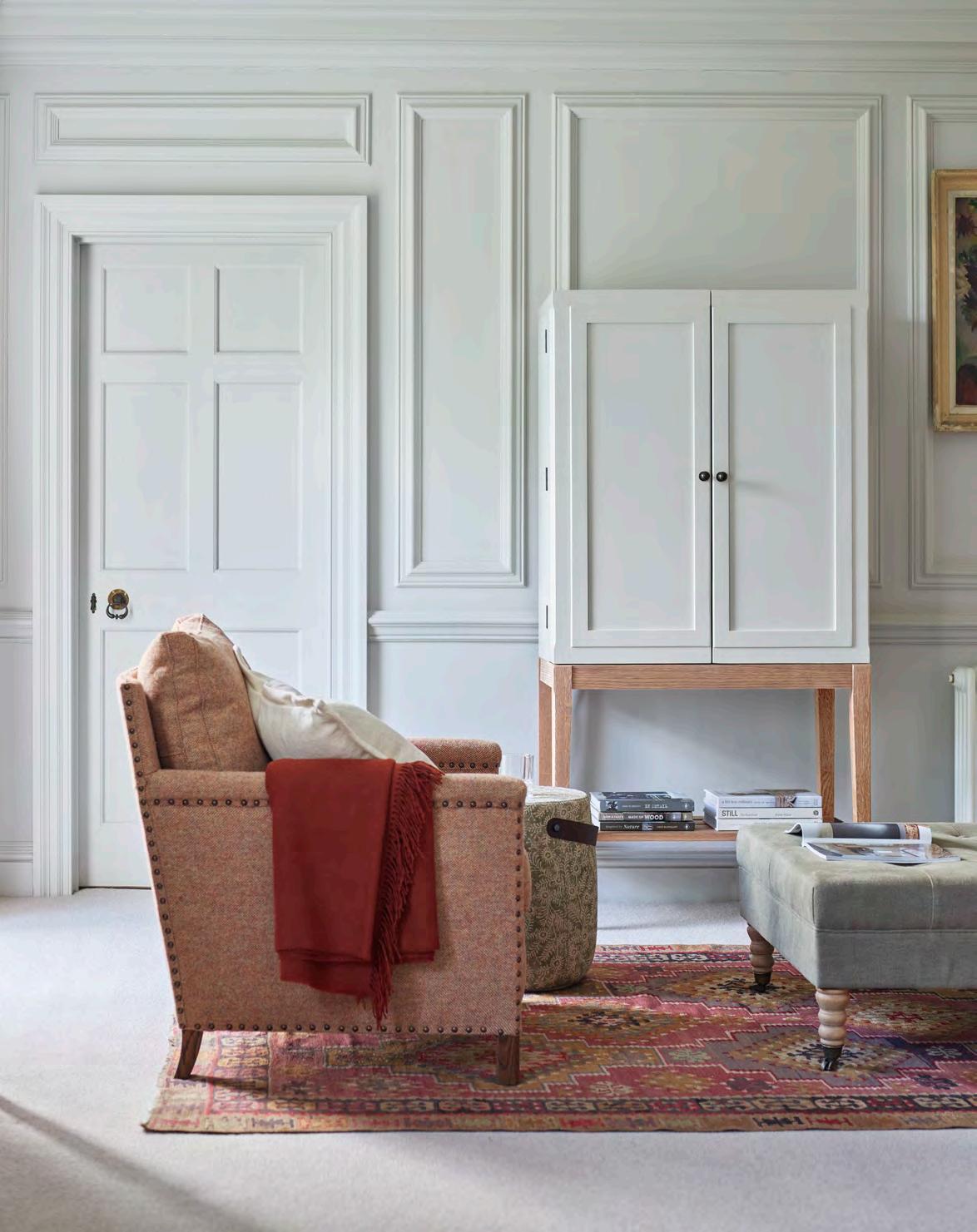 Walls and woodwork painted in Lily / Ardingly cabinet with lower shelf in Lily / Caspar armchair in Harris Tweed Marmalade
Walls and woodwork painted in Lily / Ardingly cabinet with lower shelf in Lily / Caspar armchair in Harris Tweed Marmalade
Many of us associate the reef knot with all things nautical. After all, they are named after the practice of reefing, when a sail is furled and the excess cloth is bundled together and secured in place.
And yet, reef knots are used far more widely. You will find them securing curtains, all sorts of parcels, and medical bandages. It’s also popular in jewellery-making and the primary knot used in intricate macramé textiles.
An oft repeated mnemonic for remembering how to tie a reef knot is ‘left over right, right over left.’ The reef knot can also be used to join two pieces of rope, so long as they are of equal lengths.
What you’ll need A single length of rope.
1. Hold one end of the rope in your right hand and one end in your left.
2. Pass the end of rope in your left hand over the end in your right to form a loop.

3. Feed the same length of rope under and through the loop so the two are intertwined.
4. Form another loop with the loose ends. This time, pass right over left.
5. Again, feed the same length of rope under and through the loop so the two are intertwined.
6. Pull on both ends until the knot is taut.
There you have it, the humble reef knot.
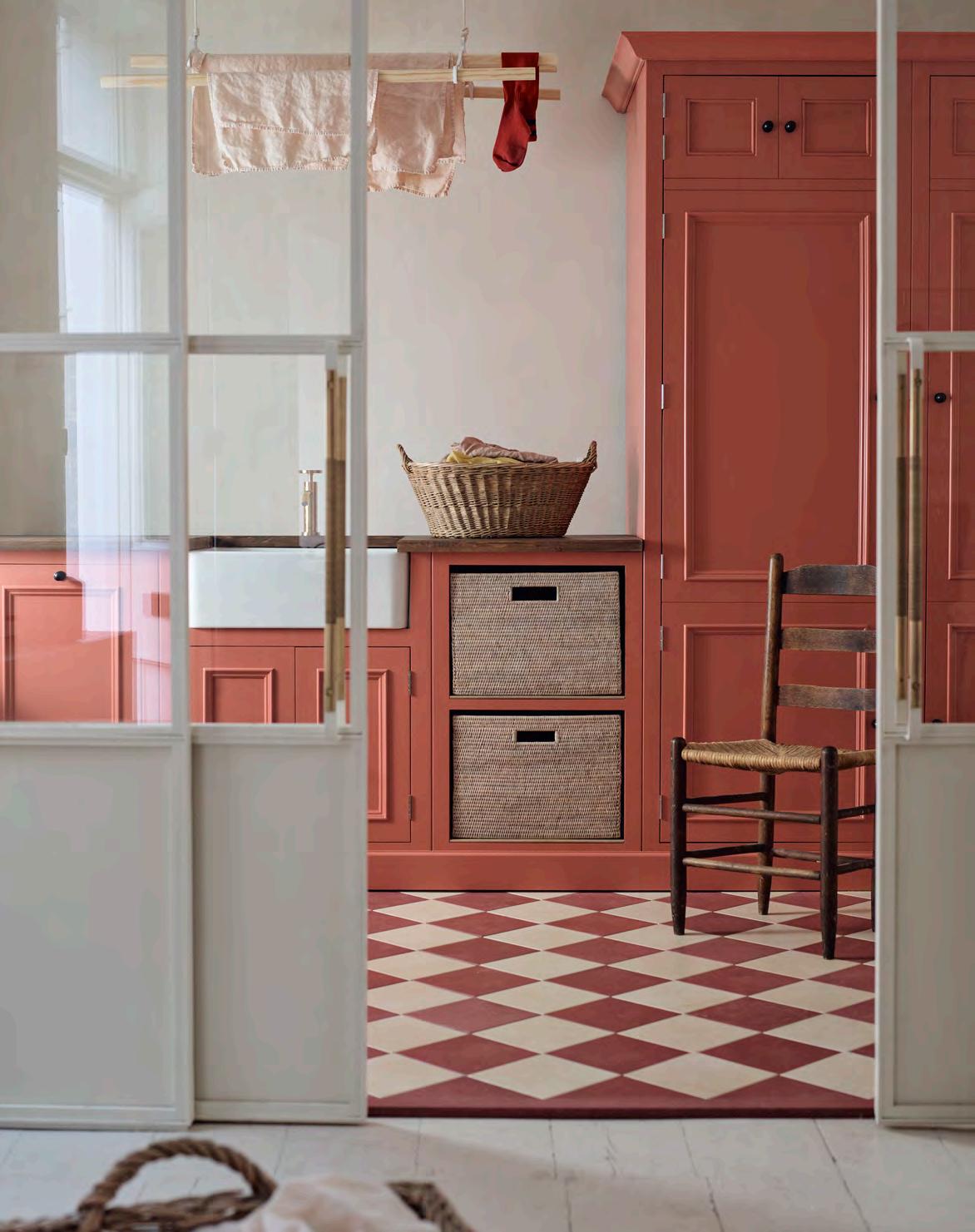
This is
RHUBARB
The utility space. The engine room of the home and as deserving of creative colour as any other part of the house. Storage cabinetry painted in our new warm, coral shade Rhubarb complements the cool hues of Salt-painted walls in a space which elevates the chore of laundry to a moment of elegant industry.
Opposite: Chichester laundry cabinets painted in Rhubarb / walls painted in SaltThe humble greenhouse, tucked in the corner of many an English garden, has a rich design and literary history, as journalist Fleur Britten discovers.
I have a thing about greenhouses. I even have a bucket list of the most fabulous ones to visit. The humble greenhouse, you see, is a temple to possibility. It is the magical missing link between the impossible dream of growing tropical plants in our endlessly disappointing climate, and the juicy, delicious reality of that.
Were I a chatelaine of 18th century England (one can dream), I too would have been right in there with my ornate orangerie – or pinery even, for pineapples – so that I could wow my guests with homegrown exotic fruits. I think of those historic hothouses – the height of technology in their day, built to defy the elements, brimming with can-do spirit – a little like the futuristic versions nowadays designed for growing lettuce on the moon; back then, they were just as radical. And yet, luckily for me, the greenhouse is now as much part of the English country garden as the rose.
Some of these period greenhouses are so evocative, so authentically preserved, it’s easy to be transported back to their heyday with a visit. To this day, Charles Darwin’s greenhouse, built in 1863 alongside his country retreat, Down House in Kent, remains filled with the same carnivorous plant species – mostly sundews – that he’d cultivated and experimented upon, and with which he rewrote our understanding of plant biology. You can practically sense the spirit of Darwin pottering away inside the greenhouse. It’s an incredibly exciting, powerful scene.
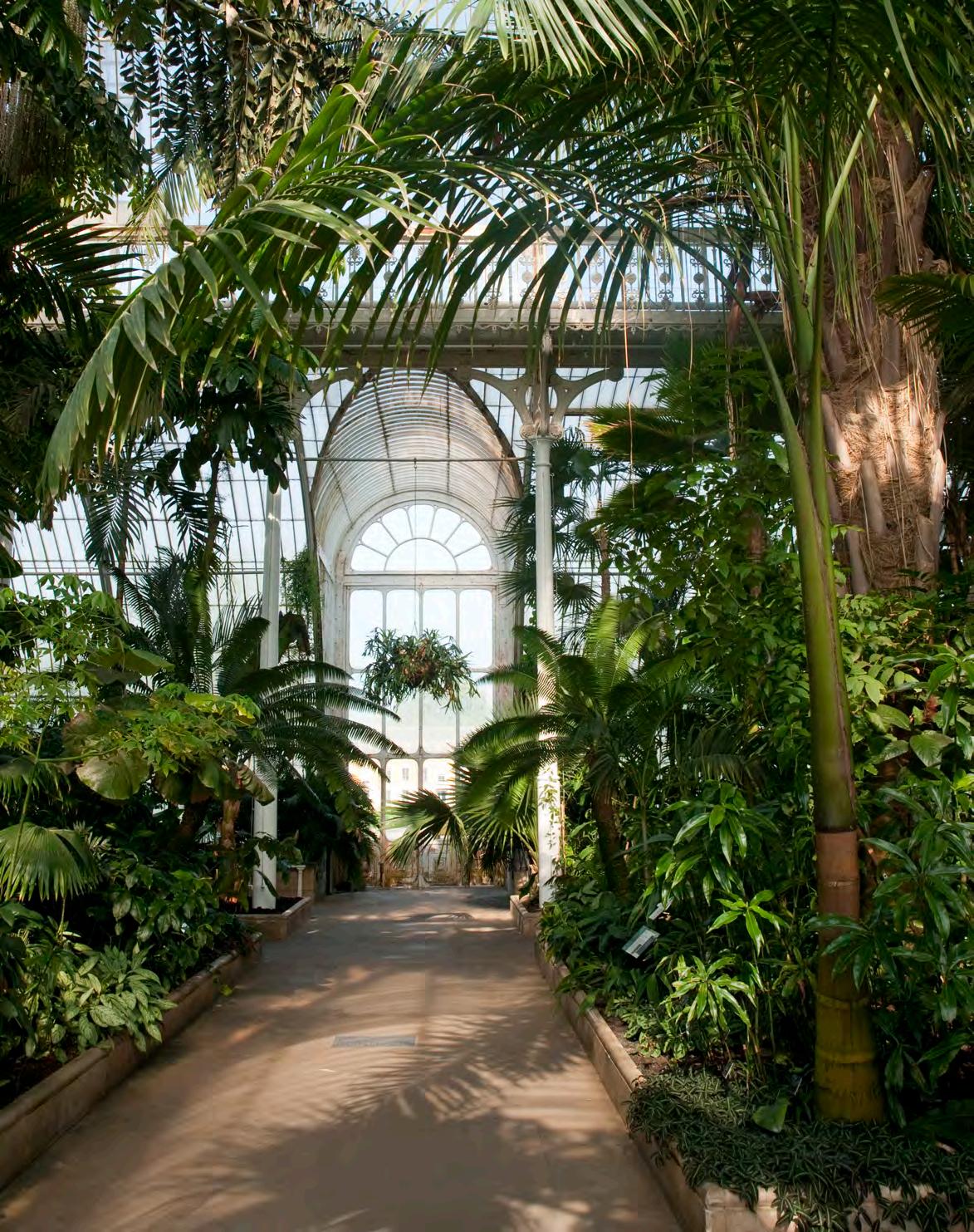
My growing collection of favourite greenhouses includes fictional ones, too. Where else to set the scene for a stolen kiss between two young lovers than a greenhouse in springtime? In Edith Wharton’s novel The Age of Innocence, when, “sitting behind a tall screen of tree-ferns and camellias” in the conservatory, the young Newland Archer “laid a fugitive pressure” on his fiancé May Welland’s lips. What fertile ground for symbolism – the fertility, the vitality, the romance!

As well as being a perfect spot for clandestine encounters, the greenhouse is a fitting metaphor for seeding ideas and concepts. The 2020 movie adaptation of Jane Austen’s Emma opens with its leading lady taking a pre-dawn stroll to her exquisite Georgian greenhouse to cut flowers for her governess. “Not that one,” she says curtly to a maid. “The next.” That micromanaged hothouse environment sets the tone for the unfolding of Emma’s controlling manner over the course of the film.
I like to channel Emma when I visit these great glass palaces of the past, nonchalantly floating around, choosing which blooms to behead for my extravagant bouquets. Of course, some of our finest hothouses can only exist in my imagination. Those of Joseph Paxton, the Victorian gardenerturned-greenhouse architect – namely, Chatsworth Great Conservatory (where he famously cultivated the Cavendish banana), and Crystal Palace, built in 1851 and arguably the most famous, most copied glasshouse in history – may not have stood the test of time, but without them, it is believed we would not have skyscrapers.
Every time I visit the Palm House at Kew Gardens (designed by Decimus Burton and completed in 1848; the first large-scale structural use of wrought iron, holding some 16,000 panes of glass), I like to imagine myself as a Victorian gentlewoman and wonder what equivalent modern marvel this glazed revolution might have felt like to her.
Well, we have ample contemporary iterations for that. The new millennium has seen equally superlative design classics built around the country. Pioneering sustainability, Cornwall’s Eden Project irrigates its 5.5 acres of exotic and endangered plant life – encased in iconic geodesic domes – with rainwater alone. Meanwhile, resembling a giant raindrop upon the Welsh countryside, Foster & Partners’ Great Glasshouse of the National Botanic Garden of Wales is the largest single-span greenhouse in the world. The Sheffield Winter Garden, contained within 21 parabolic larch arches, is the largest urban glasshouse in Europe. And guess what – the Great Glasshouse was re-envisioned as a plantfilled biome on Mars for Doctor Who. That really would be the ultimate bucket-list greenhouse.
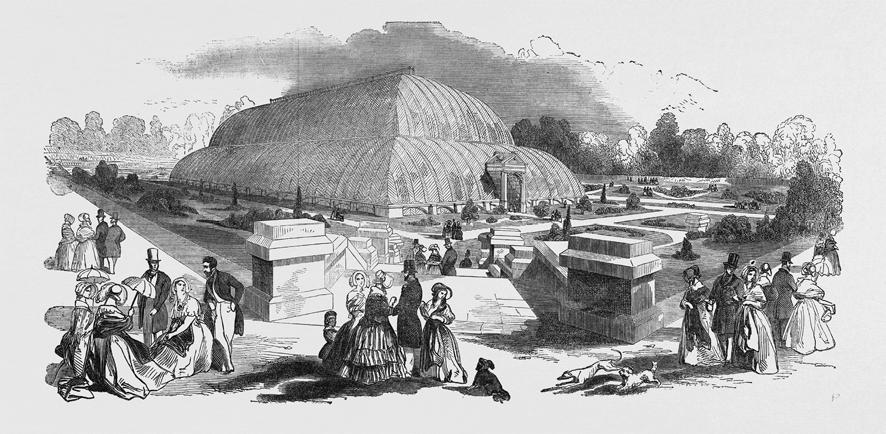 Engraving of The Great Conservatory at Chatsworth, 1844
Engraving of The Great Conservatory at Chatsworth, 1844

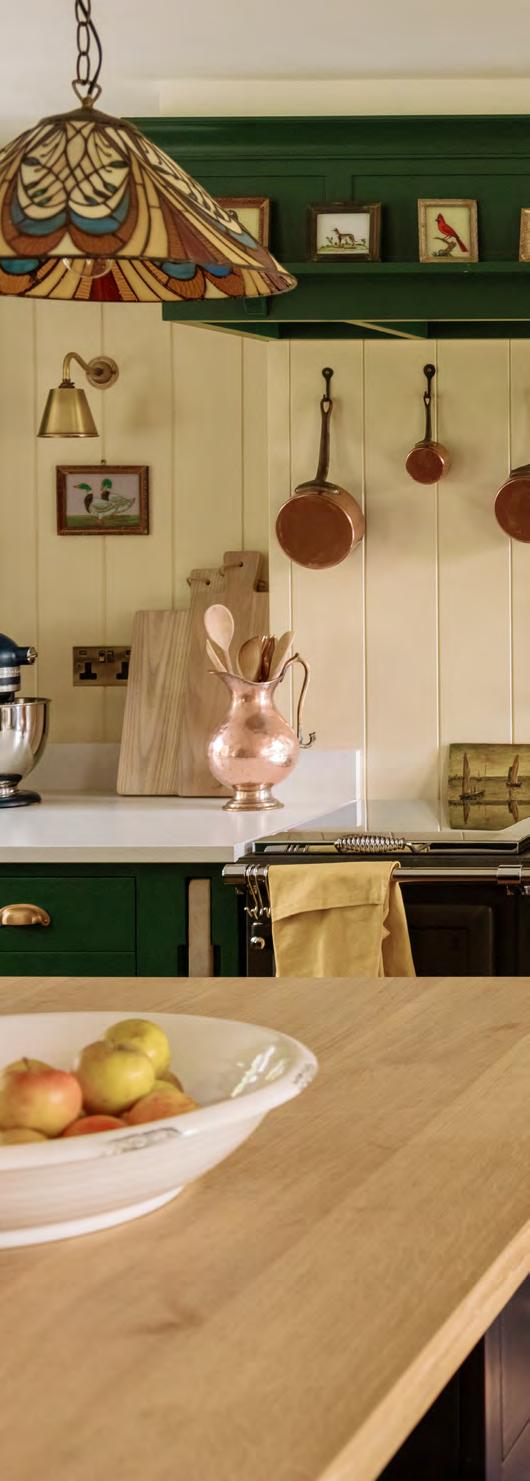
Built in the early 20th century from brick and flint, this former gatehouse in the Chilterns is home to broadcaster and explorer Ben, his wife Marina, a podcaster and antenatal educator, their children Ludo and Iona, and dogs Storm and Swift. Their home – in a rural spot with a ‘big, beautiful and wild’ garden – is situated in an area of personal significance. “My grandparents bought a house in the village here in the forties,” explains Marina. “It’s where my father grew up, and later met and married my mother. And my sisters live nearby too. It’s a close community where families have known each other for generations.” For Ben, who began visiting the area some fifteen years ago when he first met Marina, there was no doubt about where the couple would put down roots: “The more time you spend here, the more you come to understand how special it is.”
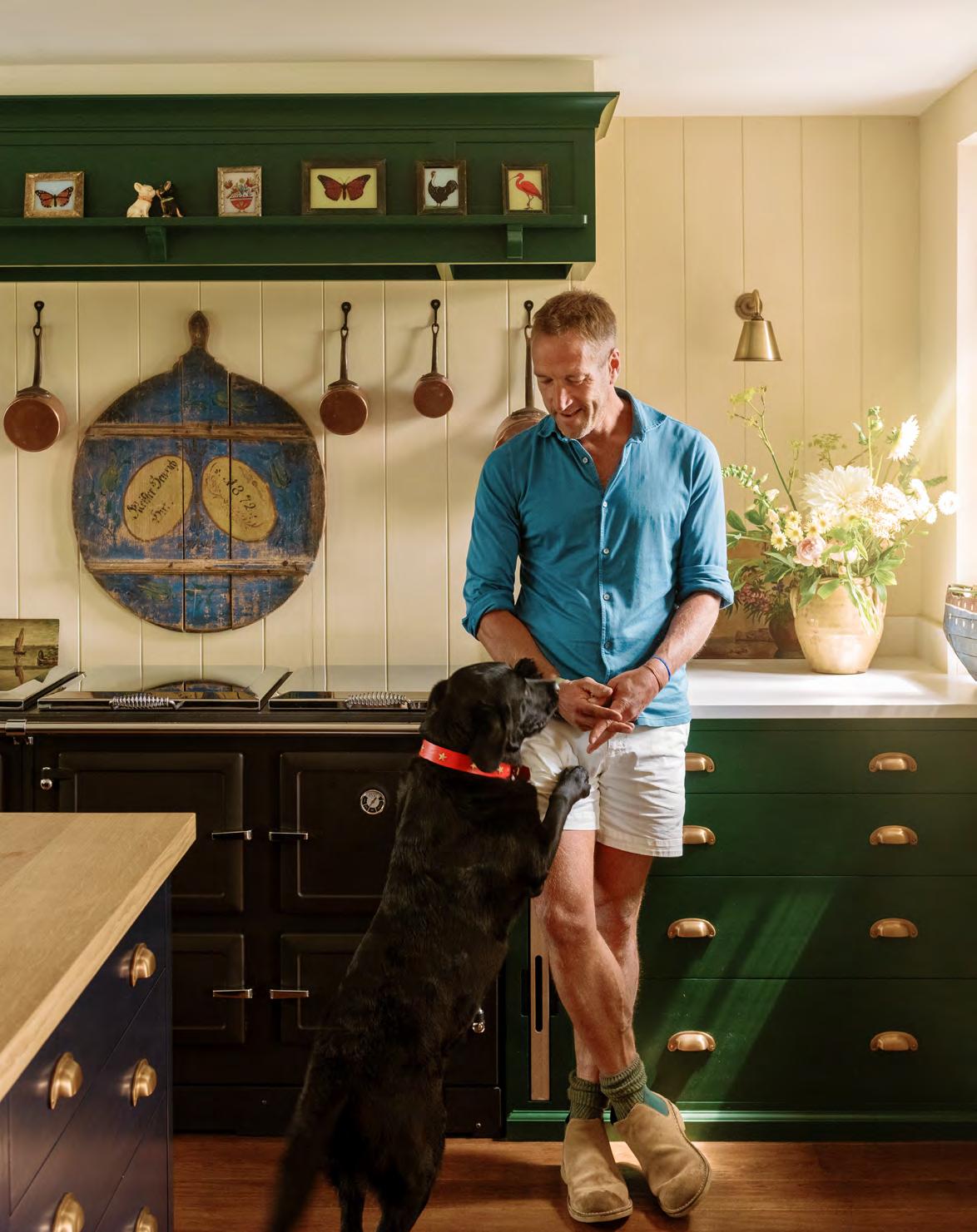
When Ben and Marina bought their home in 2018, they set about transforming it into something truly special. An ‘outside-in’ house that responded to the seasons, and one that celebrated ‘beautiful, modern functionality.’ Unsurprisingly, the kitchen was an integral part of the redesign. Intent on creating a room that could bend and stretch to fit family life, space and durability were absolute necessities. “It’s rarely just us. We’re very sociable and love an open-door policy, so we wanted a room that was perfect for plenty of people and pets,” says Ben. “We needed to know it could withstand spills and bumps too. The more marks the better, I say – it’s reflective of fun, life and chaos!” Marina adds.
Both agreed the design should complement the architecture and style of the property. “The house is 120 years old, and humble. We didn’t want anything too shiny, but favoured a pared-back timber kitchen that felt organic. And something that would still work in twenty years” explains Ben. So, with timeless simplicity in mind, the couple visited Neptune Chiswick to gather ideas for their new space. “We’re both big devourers of magazines and had long noticed Neptune adverts. I loved that the pieces were beautiful but robust,” Marina explains.
With strengthened notions of what they wanted, Ben and Marina turned to designer Kelly at our Wiltshire HQ for help with putting the pieces together. “She appreciated what we wanted, as well as what was sensible,” Marina continues. Must-haves for the kitchen included plenty of work surfaces and a generous island, two dishwashers and a ‘huge’ fridge.
When it came to choosing the right cabinetry, it was Shaker-inspired Suffolk that prevailed. “We liked the simplicity of it. It has clean lines, and felt right for the house,” Ben explains. But it was also important that the kitchen didn’t feel too homogenous. “We wanted the design to look like three separate components – the breakfast larder, the island and the cabinets – and not like a matching suite’’.
Accordingly, the couple used colour, as well as a blend of old and new, to create the kitchen’s distinct look and feel. “We love to collect anything unusual or unique from fairs and online. With the nature of Ben’s work, it just fits,” Marina muses. “And the colours, like Farrow and Ball’s Duck Green, are shades we’ve loved ever since we’ve been decorating our homes together,” adds Ben. “They’re a real celebration of the garden, wildlife and surrounding countryside. We really liked that we could introduce them to the different parts of the cabinetry to make it our own.”
How do you feel about the space now?
It’s everything we wanted. What’s so beautiful about living in an outside-in house is that it changes with each season. There’s nothing nicer than drinking coffee in the kitchen to birdsong. And we have an Esse range cooker which, in winter, makes the room even more of a warm family hub.
The dog food drawer – it’s genius! We wanted a bespoke drawer designed for storing dry dog food. It’s the perfect height and within reach of the sink. The corner cupboard with the carousel is well used too. And Kelly’s suggestion that we include cabinets with chopping boards and trays either side of the range was brilliant.
To start designing your Neptune kitchen, visit us in store or online to book your first, free consultation.
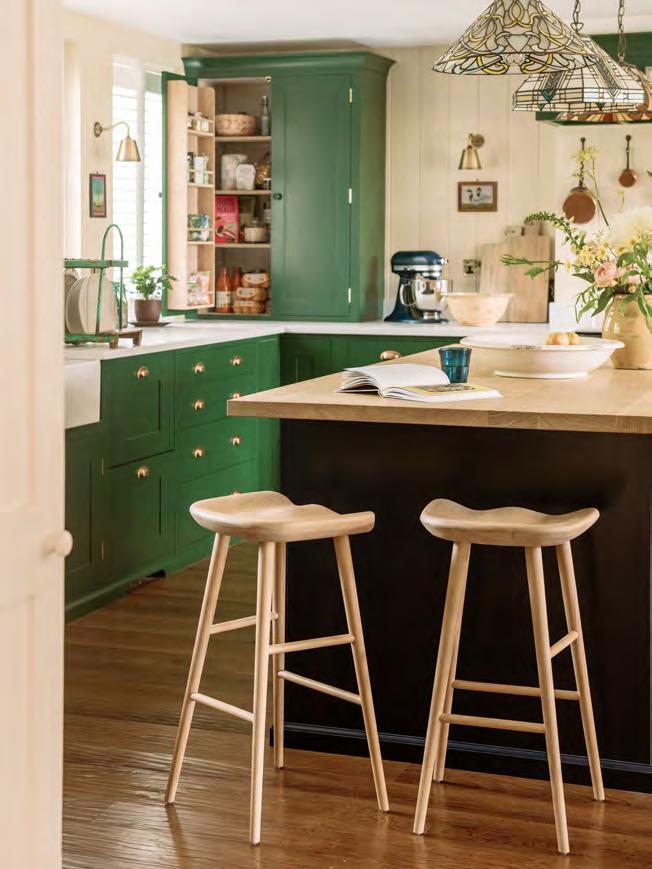

LUTHIERY, THE MAKING OF STRINGED INSTRUMENTS, IS A CRAFT THAT REQUIRES PRECISION AND PASSION TO CREATE INSTRUMENTS THAT EXCEL IN BOTH SOUND AND BEAUTY, AS INTERIORS JOURNALIST JESSICA DOYLE DISCOVERS.

There is a particular guitar that stands out in the mind of guitar-maker Daisy Tempest. “A client asked me to make one using wood from a walnut tree planted by Queen Victoria,” she recalls. “Walnut happens to have a great sound, but for that client it wasn’t about the sound, it was all about the story.”
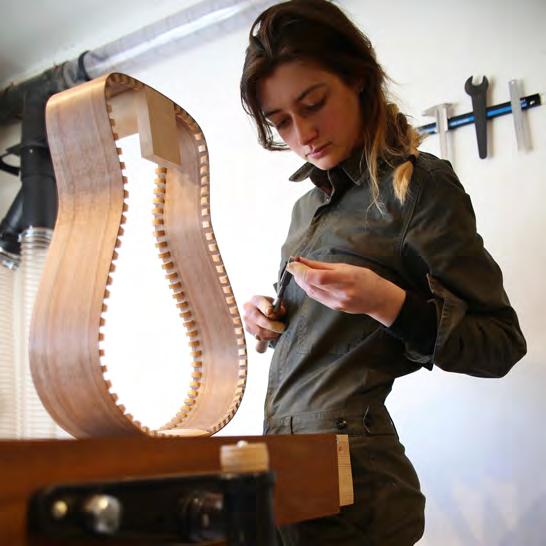
It’s an example of the thought, care and level of bespoke detail inherent in the art of luthiery, the making of stringed instruments. And for the serious musician, there can be no better design object than a custom-made instrument, designed to your personal specifications in terms of both sound quality and the beauty of the piece.
The term luthier derives from ‘luth,’ the French word for lute, and the path to becoming one is, one suspects,
different every time. “You look at a guitar and think, no one can make one of those,” says Daisy. She decided to try to do just that, however, in her early twenties, after taking a masters in English but subsequently realising that what made her happy was not so much crafting the written word, as making things with her hands using natural materials. A scholarship from QEST, the Queen Elizabeth Scholarship Trust – a charity founded in 1990 that supports British craftsmanship and traditional skills by investing in the training and education of talented makers – allowed her to work with Rosie Heydenrych, the only other female luthier in the country. Another award, of a workshop space at Cockpit Arts in Deptford, then enabled Daisy to set up her own business there in 2021.
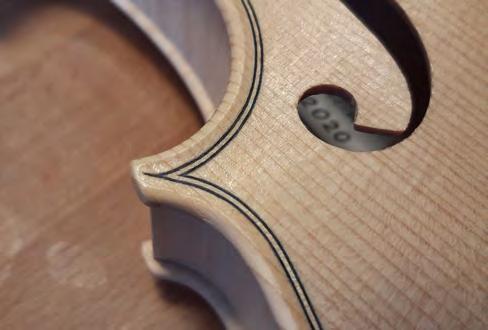
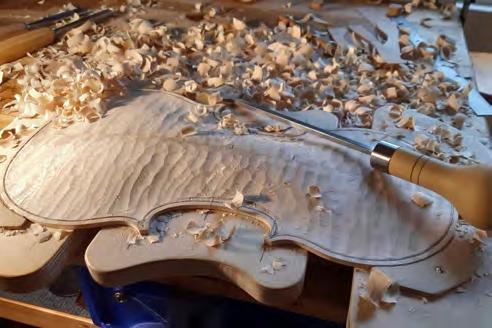
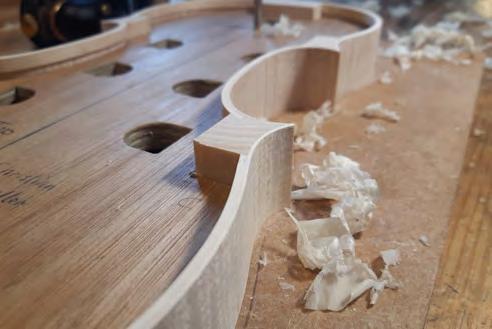
For Christian Müller, his introduction to the art of violin-making came somewhat later, after a career as a mechanical design engineer. “I wasn’t happy in my job, and I had enjoyed woodworking since I was a child, so I thought maybe I could make my hobby my work,” he says. “My wife is a violin player, and I took it up myself a few years ago, so I decided to quit my job and go to college at a very late stage.” A course at Glasgow Clyde College in 2019 was followed by a QEST scholarship, which gave him an internship with a luthier and funding for the materials needed to make the instruments.
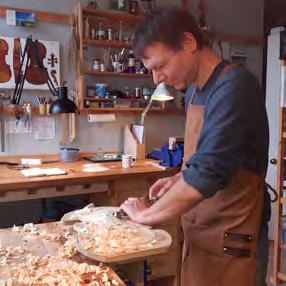
Making a violin or guitar is a long and painstaking process; it took Daisy a full year to make one guitar while she set up her studio – and she hopes to make six this year – while Christian expects to make around four violins. His process starts with a thick piece of maple, which he hand-cuts and hand-carves to make the shape and contours of the violin’s top plate, down to a thickness of 2mm in places. In both violin and guitar-making, the top and bottom plates are connected by thin strips of wood that are steam-bent to make the curved sides and glued into place – a precise job that can have a significant impact on the sound, says Christian.
Any number of other factors can influence the sound quality and user experience of a finished instrument, be it the position of the sound post (a small stick on the inside of the violin that connects the front to the back); or the string action, which determines the height of the strings on a guitar.
For many, the aesthetic appeal of the instrument is also key to their enjoyment of it, and the bespoke process allows clients to be minutely specific about their instrument. It also allows the maker to put their own stamp on the instrument, too; the design process, says Daisy, is “very much a two-way conversation”. For Christian, the hand-carving is key, as is the varnishing, which is “considered quite a science in violin making; it can make the wood look sparkly and golden”. Daisy’s signature is marbled paper (made by Lucy McGrath, also at Cockpit Arts), which she uses to make a coloured inlay around the soundhole of the guitar. Each finished instrument is naturally unique, destined to give its owner a lifetime of enjoyment. As Daisy puts it: “It’s like the difference between a high-street suit and a bespoke suit with a tailor-made pocket. Nature has given us this tapestry of material options; whatever you want, there will be a way to make it work.”
Discover more about the QEST scholarship programme at qest.org.uk
Tempest Guitars tempestguitars.com
Christian Müller christianmuellerviolins.com
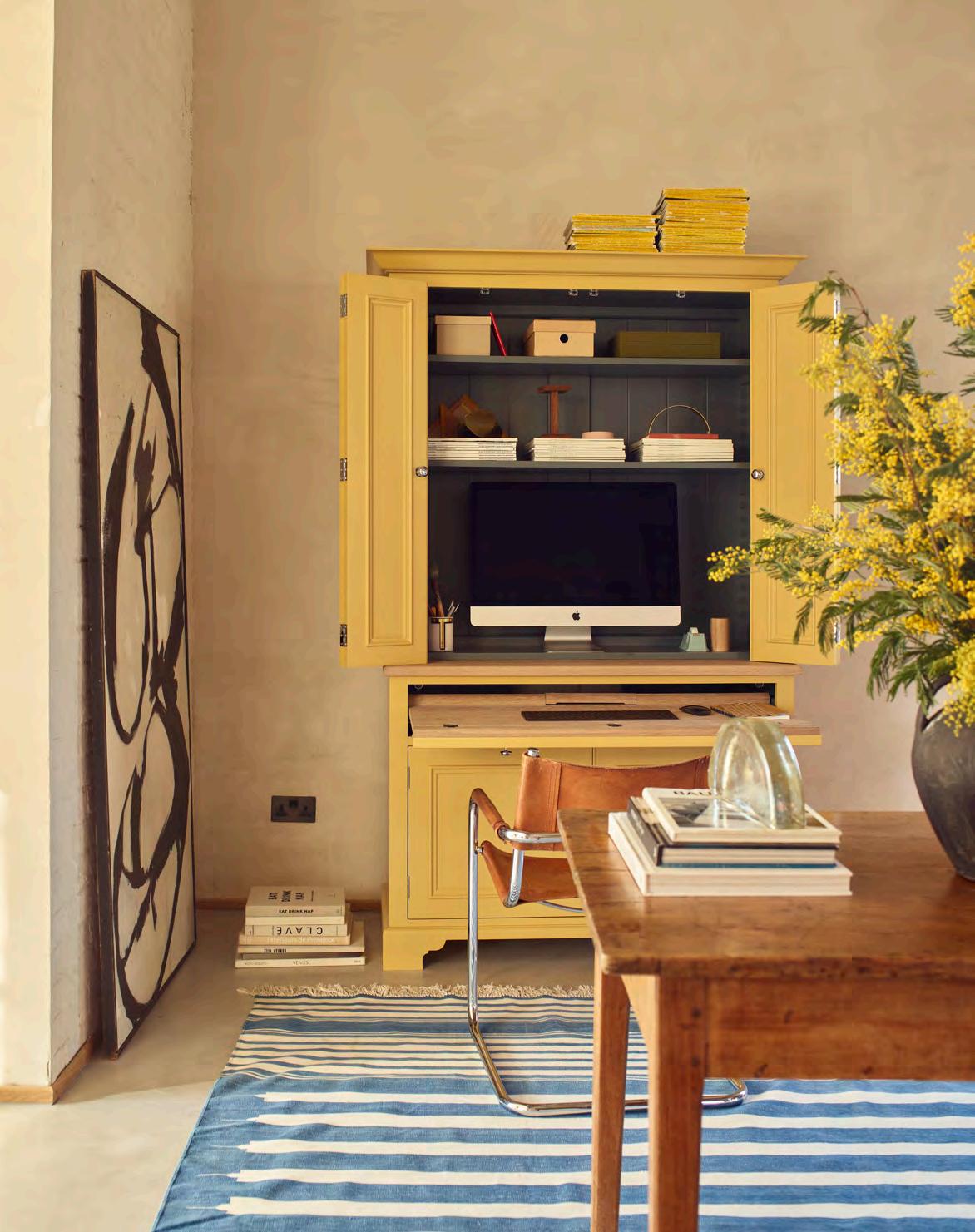
This is the
The timeless Chichester dresser was one of the first pieces of furniture designed by co-founders John Sims-Hilditch and Giles Redman. Created to sit as a freestanding piece within the Chichester kitchen collection, its versatility sees it reimagined today for the demands of home working. With spaces for cable management and ventilation, lockable drawers, and a pull-out oak writing surface, this is a complete modern office which folds away to blend into the room at the end of the working day.
Whether for companionship or delicious fresh eggs, keeping hens requires a safe house and clear pecking order, according to gardener, podcaster and avid hen-lover Arthur Parkinson
Arthur Parkinson’s latest book, Chicken Boy, part-memoir, part-tribute to his love of rare and fancy chickens, will be published in April 2023 by Penguin Random House.


The key to ensuring the contentment of any animal is to understand it. Chickens are no exception; the biggest clue to having happy hens can be found by looking at the jungle fowl ancestry of the domestic hen.
They originated from small, pheasant-like birds, creatures of leafy woodland floors, feeling secure scratching about in little flocks. Today, in a back garden or smallholding setting, chickens find comfort in orchards and shrubberies, as canopies help them feel safe.
Keeping hens secure is the biggest concern at home; foxes, badgers and rogue dogs all are threats. For this reason, I like to have my hens in aviary-like coops that ensure their safety.
Not everyone will be able to keep hens in the garden. Hens love to peck about on the lawn, but they can cause herbaceous havoc while they dust bath, which is a chicken version of a spa ritual and an essential activity for ensuring fine feathers. They are also avid sunbathers and love to perch on thick branches or old garden furniture. Perhaps better for some is to keep hens on an allotment where a whole plot could be fenced off as a generous hen run. Or you could consider adapting an airy summer house into a hen house and giving the birds an attached coop by using a galvanised wire fruit cage attached at the side.
The more space hens can be given, the happier they will be and the less harsh the pecking order – ranking from head to bottom hen – will be. This hierarchy can

make it hard to introduce new birds to an established flock, so buy in groups of at least three from recommended breeders, when they are at point of lay at 18 weeks old, and avoid auctions. You can also adopt ex-commercial, hybrid layers. It is a rewarding thing to watch these feather-pecked retirees regrow their feathers and live a proper life after their abhorrent start as battery girls.
Keeping a clean hen house is essential to stop red mites; a parasite menace that sucks the hens’ blood as they roost, causing anaemic birds. Rats are traditionally an issue due to lazy habits such as mess and uneaten chicken feed lying around, so use a rat-proof feeder like RoamWild’s which allows the birds to dine throughout the day but doesn’t attract vermin, and keep the hen house raised off the floor too.
Hens have strong personalities. It’s not all about eggs, which aren’t produced endlessly as laying patterns are dictated by a hen’s age, diet, and even the seasons. Short winter days see egg numbers dip hugely. Young hens lay well, however mature hens lay larger eggs.
If eggs are your chief concern, then Burford Browns, Speckled Sussexes, Hamburgs, and Cuckoo Marans are my favourites, as well as Cream and Cotswold Legbars with their blue shells. Otherwise, for companionship, opt for the docile Orpingtons or Cochins. Pekins, Belgian Bantams and Silkies are smaller, so a good choice for small gardens.
At the time of going to press, Arthur notes, hens must be in covered coops due to the risk of bird flu – a government requirement aptly coined ‘flock down’ – to reduce the risk of hens coming into contact with infected wild birds and their droppings. Hopefully by late Spring, free ranging can happen once more. Eggs were almost rationed over this past winter, so having laying hens at home really can provide food security and self-sufficiency.
A craft initiative, born during lockdown, is now coming to fruition in Neptune stores.

One positive to emerge from the tumultuous months of the pandemic was a renewed appreciation for our local areas. Exploring streets and footpaths that we oft ignored in our busy lives, and rediscovering neighbourhood stores and artisans. It was in this spirit that design curator and advocate Barbara Chandler approached Neptune with an idea to identify and champion fine craftspeople working near our London stores, commissioning exclusive pieces with a strong sense of place.
The Neptune makers collection was launched in 2022, and the commissioned pieces went on show in our Fulham, Chiswick and Wimbledon stores, with all proceeds going to the makers. So, please meet our first six makers and their locally-inspired designs.
“I am celebrating this beautiful city I call home,” says stitch artist Ekta Kaul, whose London Map Embroidery Kit for Neptune is a specially drawn map with London landmarks printed on a linen/cotton fabric. It comes with everything you need to create your own sampler, including a stitch guide, embroidery hoop, needles, and thread. You can embroider as much or as little as you like, highlighting favourite places, as the print will tell the story even if not stitched.

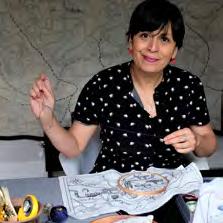
“In a world where everything is available everywhere, the value of local is heightened,” say Ekta, who studied at
India’s premium design school before coming to the UK for her MA. “Art and objects made by local makers forge a deep material connection, infusing our homes with a spirit of place.”
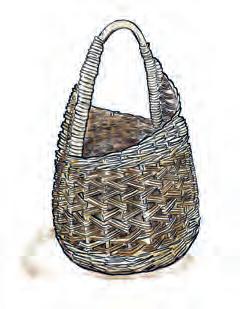 by Eleanor Morgan
by Eleanor Morgan
West London basket maker Eleanor Morgan has created two baskets for Neptune. Handles are in solid bent willow and the baskets are made in the traditional “stake-and-strand” style. “These baskets meld utility and function with a sculptural form,” says Eleanor, whose willow comes from the Somerset levels –the traditional area for willow growing.
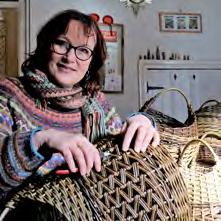
Historically, she explains, willow would have been grown in most communities to make the essential baskets of daily life. Baskets used in the market gardens of Hounslow and Isleworth were made in Kew and Kingston from willow grown near the Thames. Nowadays, though, it’s a question of foraging. “Some of the handles for these baskets were foraged from North Ealing, some from Newmarket and I grew a small amount on my allotment in Isleworth.”
@ekta_kaul ektakaul.com
“For me, it’s all about provenance,” says Eleanor. “People are surprised to find not only that baskets are still made in this country, but that there is a maker just up the road.”
@WoodWoolWillow WoodWoolWillow.com
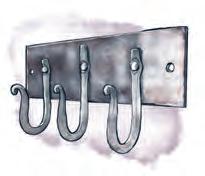 by Neil Brown
by Neil Brown
Working from his forge at Brentford Museum of Water and Steam, artistblacksmith Neil Brown has made a single and triple set of hand-beaten hooks for Neptune, riveted to a backing plate with holes for wall-mounting, all finished with a museum-quality wax.
“I love the way a smith can take a hard, unforgiving material, make it soft and malleable, and turn it into an object of beauty,” says Neil whose forge is the oldest in London in continuous use, dating back to the 1800s.
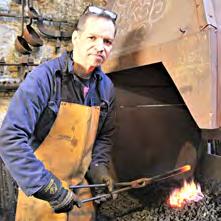
“Hand-forged metal work has a soul. You can see almost every strike the blacksmith has made, leaving a part of the smith in
every piece.” The hooks will become more polished as you use them. “When you have locally-made iron in your home, you continue a long history, becoming part of the story. As you put things on and off, you’ll add your own story,” says Neil.
 by Lucy Mayes
by Lucy Mayes
Pigment maker and artist Lucy Mayes has created an exclusive collection of colours for Neptune which she has made into hand-painted colour charts – “works of art that are a unique portrait of a place in time.” Trained in fine art, Lucy started making her own paint colours years ago. Some pigments come directly from the earth – “traditional” ochres. Others are the natural plant dyes, along with the “flotsam and jetsam of the street”: bricks, slate, and charcoal ash. “I love this close relationship with the places my pigments come from.”
In Fulham, Lucy explored the Thames foreshore, collecting fragments of Victorian clay pipes. Eel Brook Common produced a soft yellow brown and Hurlingham a darker shade. In Chiswick, Lucy found mussel shell and medieval clay tiles on the shoreline to grind and make

@hot.metal.works hotmetalworks.co.uk
into paint. Further inland, Gunnersbury Park yielded earth colours. “And I made a green-black paint from flakes off the railings at Turnham Green.” From Wimbledon Common came yellows from Hawthorn berries and Dyer’s Weed. While, to celebrate the area’s tennis history, she made “grass green” by mixing weld and verdigris. “And I extracted carbon black from a wooden antique racquet.”
@london pigment londonpigment.com

 by Alexandra Browne
by Alexandra Browne
Alexandra Browne struggled to find tiles for clients when running her own interior design practice, so, “I decided to paint them myself!”, she explains. Her initial Pampelonne series – inspired by the French Riviera – was immediately successful. Alexandra has adapted her elegant style to reflect our Neptune London localities. The result is little squares of handmade and hand-painted ceramic art. “Wimbledon was the easiest. How could I not do tennis?” Chiswick evokes the river and Fulham has a parade of strollers along the King's Road.
Today, tile-painting is Alexandra’s fulltime job. Each motif is painted with the finest of brushes – she wears out around one a week. And you can feel the raised
brushstrokes on the surface of every tile – a direct connection to the maker. “The homes I have lived in have always been more than just the bricks and mortar,” Alexandra observes. “When I look back, I think of them in the context of their area. So, it seems more than fitting that a home should have something of its surroundings grouted into its fabric.”
Chiswick potter Linda Bloomfield’s garden studio is where she has made a set of her signature pouring bowls for Neptune. At their base is a dark band of exclusive Thames Glaze, refined from mud collected on Chiswick Eyott. The glazed interiors are “river” shades of a rich blue-green Mallard, delicate pale Willow and ethereal Dawn pink. Linda is a “queen of glaze,” with a background in Engineering Science to underpin her ceramic expertise. “The Thames glaze is difficult to work with, as it has particles of clay mixed with iron oxide, silt, chalk, and phosphorus from decomposed plants. It shrinks in the firing and must be thinly applied, or it will peel off my porcelain clay ‘body’. But it melts in the kiln to a glossy red-brown.”
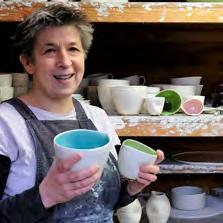
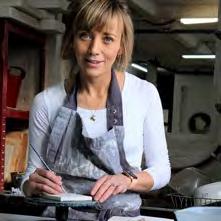
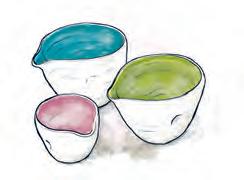
@alexandra.browne alexandrabrownedesign.com

Linda's bowls for Neptune are quintessentially local and personal. She adds: "The dimples and throwing lines are a record of my hands touching the clay. Thus, pottery can form a powerful connection between the user and the maker – and pieces can last for hundreds, if not thousands, of years.”
@LindaThePotter lindabloomfield.co.uk
Look out on our social sites for details of workshops and talks with the Neptune makers in our stores during 2023, and follow Barbara Chandler on @sunnygran
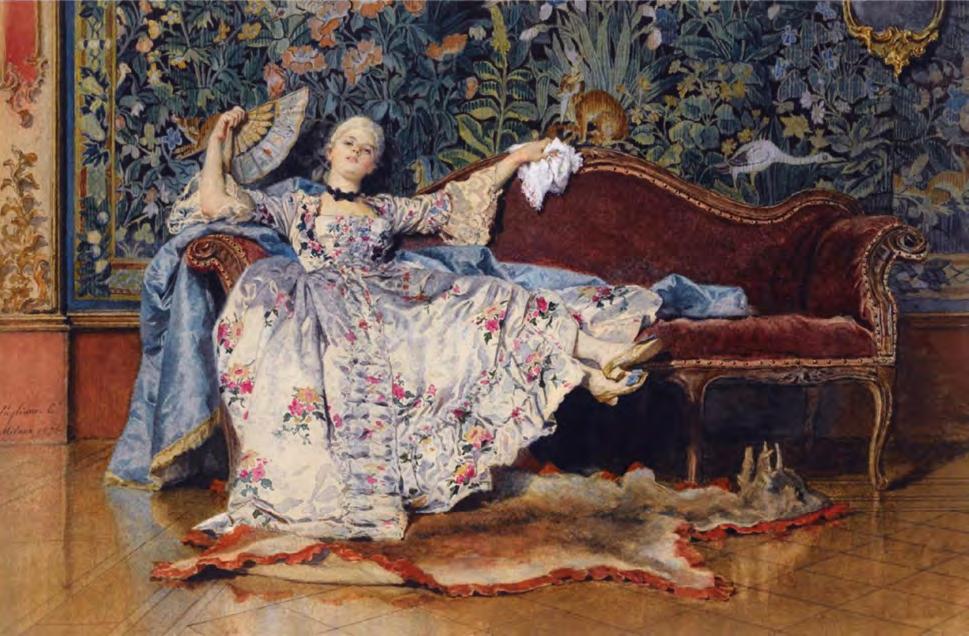 Author and blogger Paula Sutton translates the secret language of a lady’s fan.
Author and blogger Paula Sutton translates the secret language of a lady’s fan.
In this age of zoom meetings and FaceTimes, and with the galloping rate of technology meaning that we can communicate by texting, via voice notes, or even through the use of playful emojis, are we in danger of missing out on the subtle art of body language?
Are we steering ourselves away from the excitement of a stolen side glance aimed at the object of our affections, or the thrill of a raised eyebrow to indicate amusement, in favour of a laughing emoji or typed heart? And what about the gentle fluttering of a hand fan as a means of expressing our desires?
The fan has been used in well-to-do society to communicate feelings, without alerting everyone present to the fact, for centuries. At times when the behaviour of men and women was highly controlled and scrutinised, it made sense that the flutter of the fan would evolve to become a discreet way of signalling one’s thoughts.
As with everything fashionable, a set of etiquette rules were quick to follow, and as such the fan became an essential accessory in the act of Victorian flirting. With various subtle movements a lady could convey that she and her flirting partner were being watched (a’twirling in the left hand) or that the object of one’s affection could rest assured that their love was returned – the drawing of
the fan across one’s cheek symbolised “I love you”. It was even possible to give someone the gentle hint that they were destined to remain forever in the friendzone by the dropping of a fan.
In fact, there was eventually a language of approximately two dozen different fan gestures and movements that communicated a secret language known to lovers and friends alike.
There were even books written on the subject, enabling the flirting novice to negotiate their way around the treacherously scandalous waters of illicit Victorian romance. The 19th century Parisian leather goods manufacturer and fan maker Jean-Pierre Duvelleroy printed a pamphlet that detailed further meanings to hand fan positions. They included how to say, “Follow me”, “No Sir – I am engaged”, or even “I hate you”. All necessary communications at the time it seems, since by 1887 Duvelleroy had two fan shops in Paris and one in London.
What of the hand fan today? Trends tend to be cyclical and perhaps another comeback wouldn’t be such a bad idea as an alternative to our modern-day penchant for oversharing on the internet. The subtle art of 19th century flirtation would make a very welcome 21st century fan club indeed.
Carrying in the right hand in front of the face
Placing it on left ear
Twirling in the right hand
Presented shut
Open and shut
Drawing across the eyes
Follow me
I wish to get rid of you
I love another
Do you love me?
You are cruel
I am sorry
Open wide Wait for me
With little finger extended Goodbye
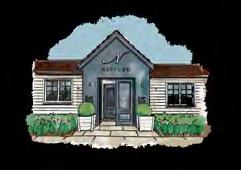





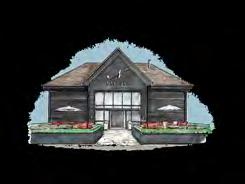
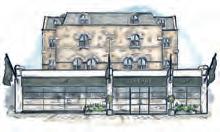

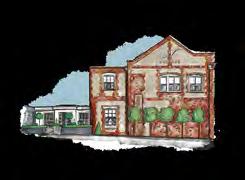
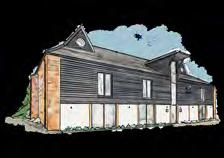
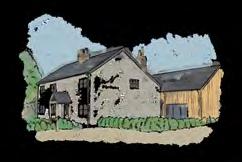
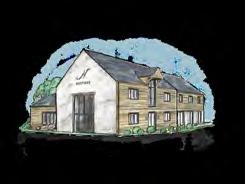
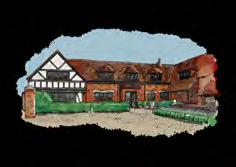

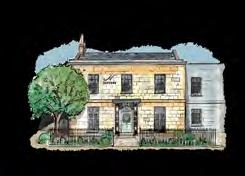
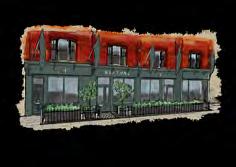
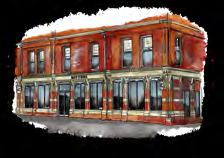
Our stores are spaces to relax in, just as you would in your own or a friend’s home. They are inspirational places, too, thoughtfully curated to showcase our approach to design.
So, while we hope you enjoy looking through this volume of Stories, we look forward to meeting you in person, too. Find your nearest store neptune.com/our-stores



UK
Bath BA1 5BD
Belfast BT7 3GB
Bristol BS8 2QY
Bury St Edmunds IP33 3PH
Cambridge CB22 7PX
Canterbury CT1 3TY
Cheltenham GL50 4DW
Chesham HP5 1NG
Chester CH2 4JR
Chichester PO20 2EW
Chiswick W4 4HH
Colchester CO3 8LT
Edgbaston B15 3AA
Farnham GU9 0BB
Fulham SW6 2TD
Guildford GU1 3AJ
Hailsham BN27 1DQ
Hove BN3 4QD
Knutsford WA16 8TA,
Reading RG10 9SA
Southport PR4 6JA
Tonbridge TN9 1RF
Weybridge KT13 8DX
Wimbledon SW19 1RX
Winchester SO21 1HL
York YO32 9TW
Wiltshire Outlet SN5 8YG
Store in store:
Neptune by Treehouse Midmar, Aberdeen, AB51 7NB
Neptune by Creative Classics, Ayr, KA7 2HD
Neptune by Sims Hilditch, Bath, SN14 8JR
Neptune by Woods of London, Blackheath, SE3 0TA
Neptune by Robert James Interiors, Coventry, CV8 3HB
We have Neptune stores across the UK, Ireland and Europe.
To see all of our homes, visit neptune.com/our-stores
Neptune by Hunters, Derby, DE1 1SY
Neptune by Richard F Mackay, Edinburgh, EH11 2SG
Neptune by Malone & Smyth, Co. Fermanagh, BT92 9BL
Neptune by Bridgewater Interiors, Gateshead, NE8 2AJ
Neptune By Closa, Tetbury, Glos. GL8 8AA
Neptune by Aberford Interiors, Leeds, LS25 3DP
Neptune by Ben Heath, Newbury, RG14 5SA
Neptune by Appleyard, Norfolk, NR25 6AR
Neptune by Wilton Kitchens, Salisbury, SP2 0HX
Neptune by Holloways, Worcestershire, WR6 5DE
Neptune by Bradley Gardens, Wylam, NE41 8JH
Neptune by 1933, Co. Meath
Neptune by Browsers, Limerick
Neptune by Global Village, Dublin
Neptune by Global Village, Wicklow
Neptune by The Orchard, Co. Kildare
Neptune by Trevor Morrow, Co. Mayo
Neptune by Castle Cabinets, Kilkenny
Neptune Paris
Store in store:
Neptune by Etat d’Esprit, Cannes
Neptune by Beaumont Chamborand
Neptune by Fabrica, Eymet
Neptune by Mi Figue Mi Raisin, Forbach
Neptune by Rosiris, Granville
Neptune by Just Kitchens, Miélan
Neptune by Hérick
Aménagement Nantes
Neptune by Etat d’Esprit, Pertuis (Provence)
GERMANY
Neptune Berlin
Neptune Fellbach
Neptune by Wooden Empire Neptune Köln
Neptune Tegernsee
Store in store: Neptune by Helma Interior, Heidelberg
AUSTRIA
Neptune by Steinwender, Wien
BELGIUM
Neptune by O&V Home Interiors, Seneffe
ITALY
Neptune by Adi Arredamenti, Brescia
Neptune by Forteshire, Forte dei Marmi
Neptune by Forteshire, Milano
LIECHTENSTEIN
Neptune by Allure, Vaduz
SPAIN
Neptune by Sacarello, Gibraltar
SWITZERLAND
Neptune by Thomas Homes, Luzern
Neptune by Styles Interiors, Rolle
Neptune by Friolet Interiors, Zurich
THE NETHERLANDS
Neptune by The Classic House, Weteringbrug (near Schiphol)
We do everything we can to make sure Stories is as environmentally sound as possible. The paper we use is all FSC-certified as coming from responsible sources, and is also carbon balanced by the Woodland Trust.
Please note that, while the colours shown in this volume are as accurate as possible, they will not always precisely match our paint shades.
